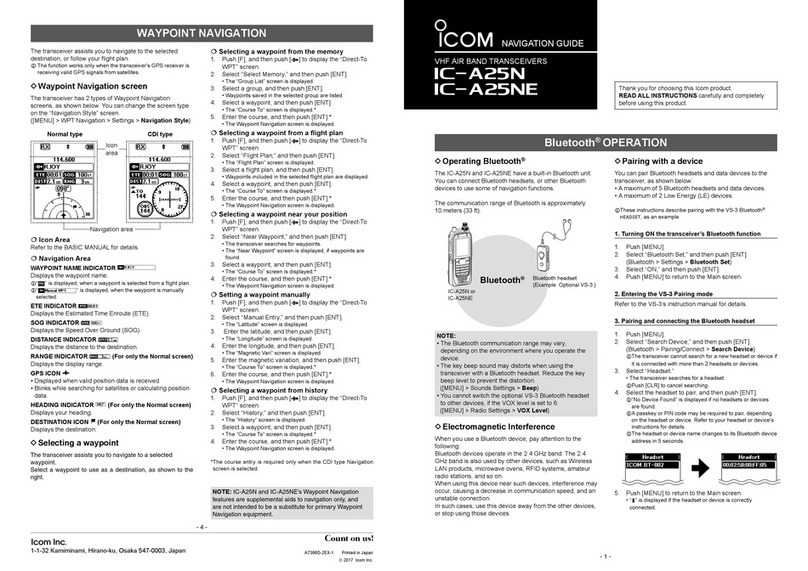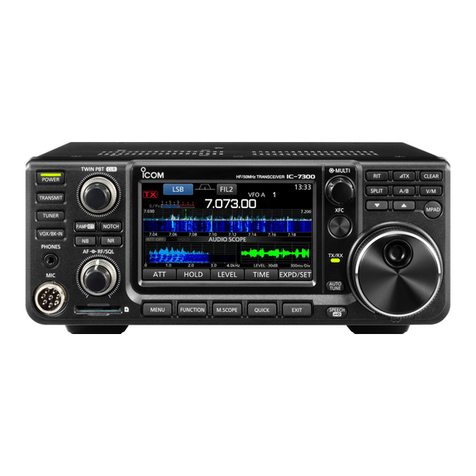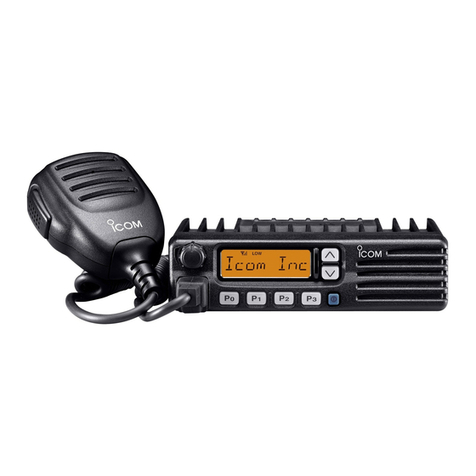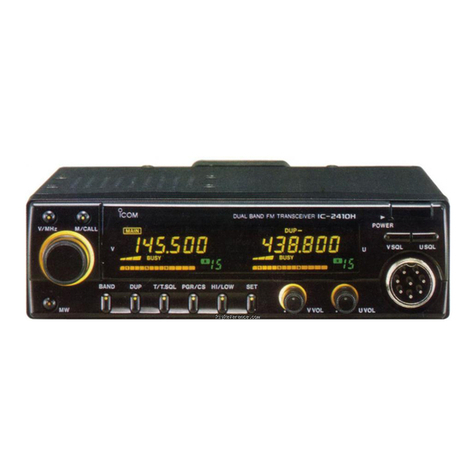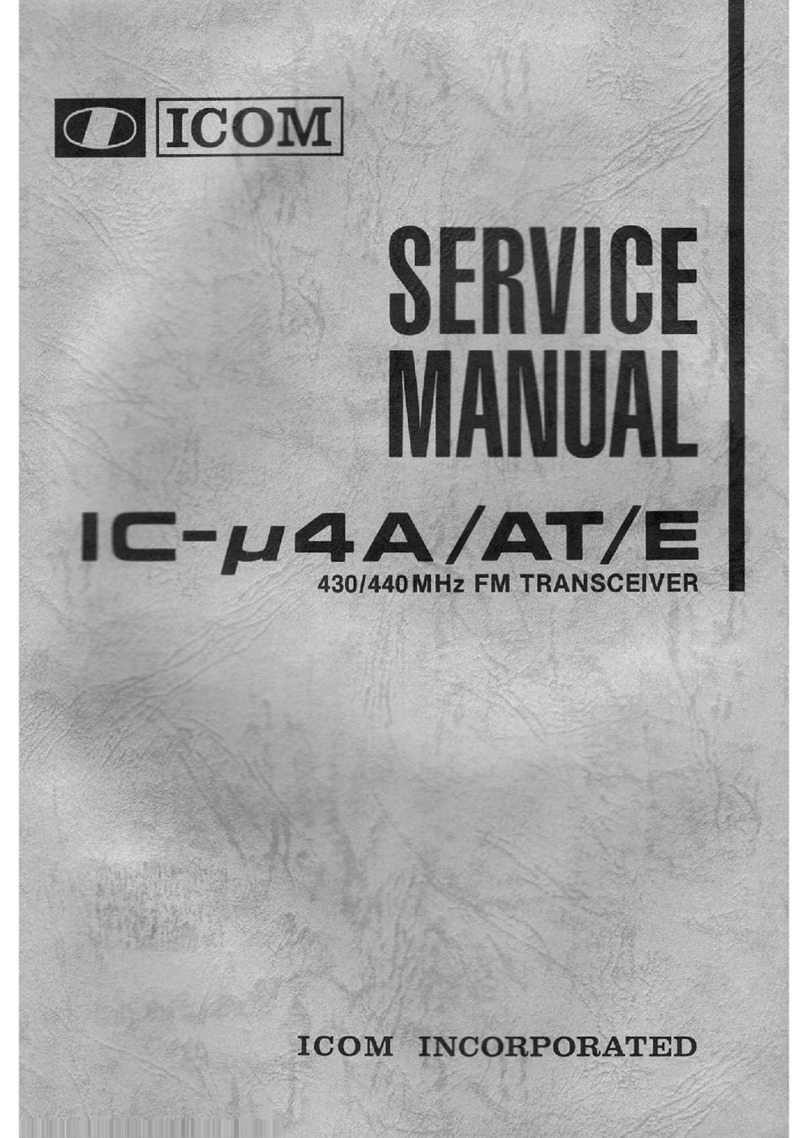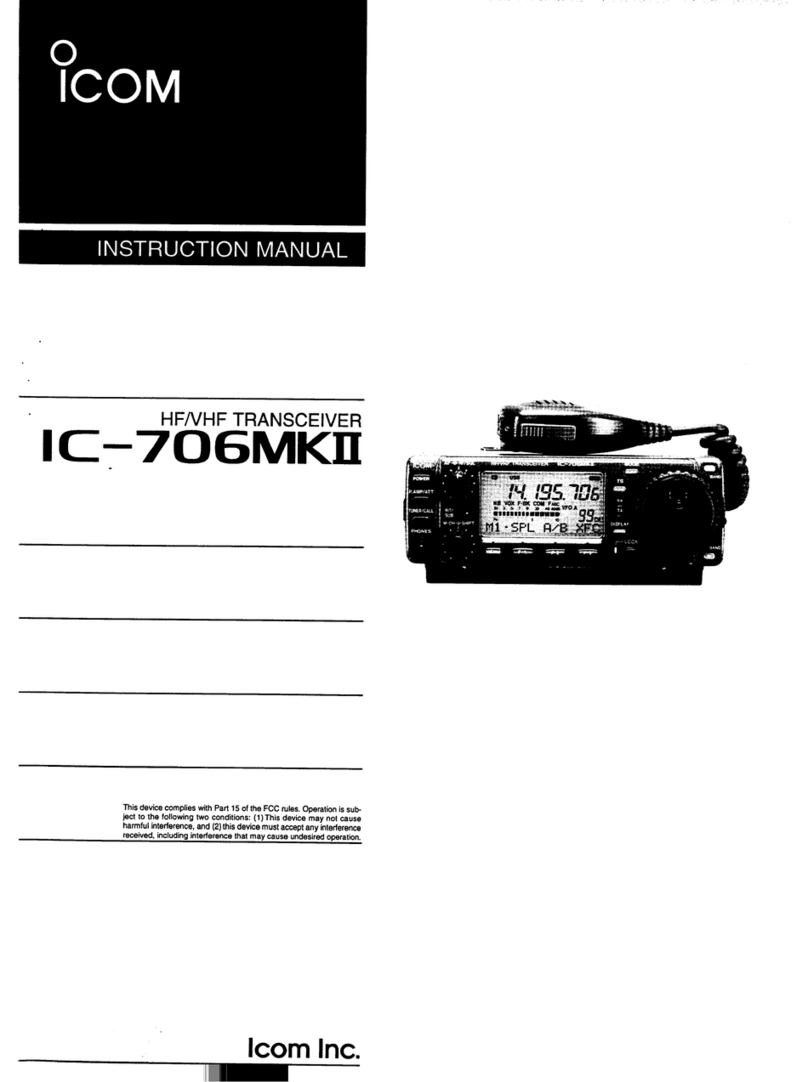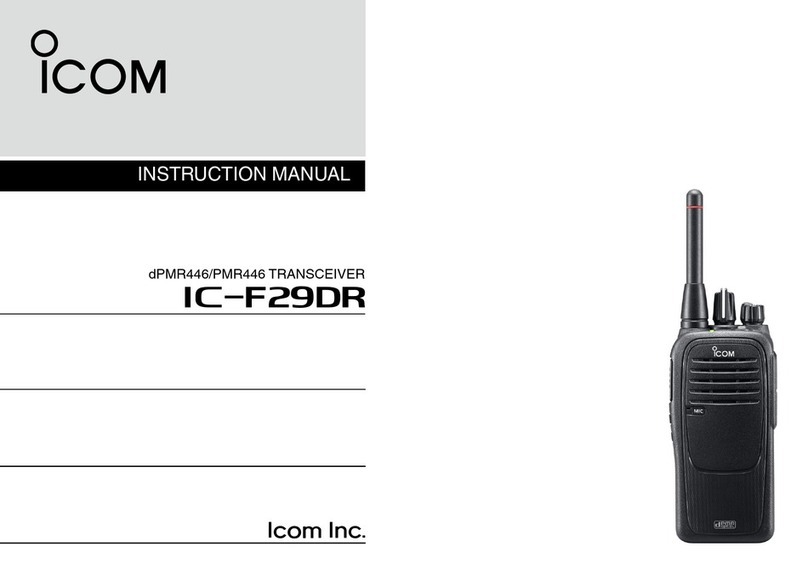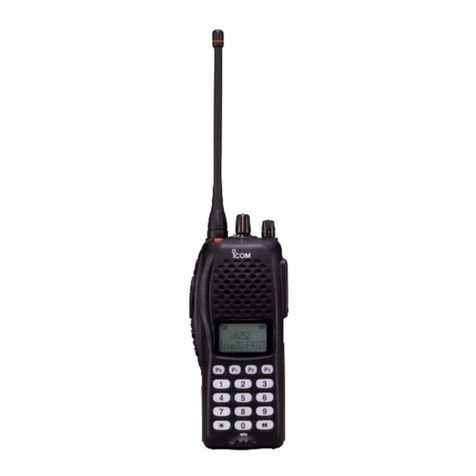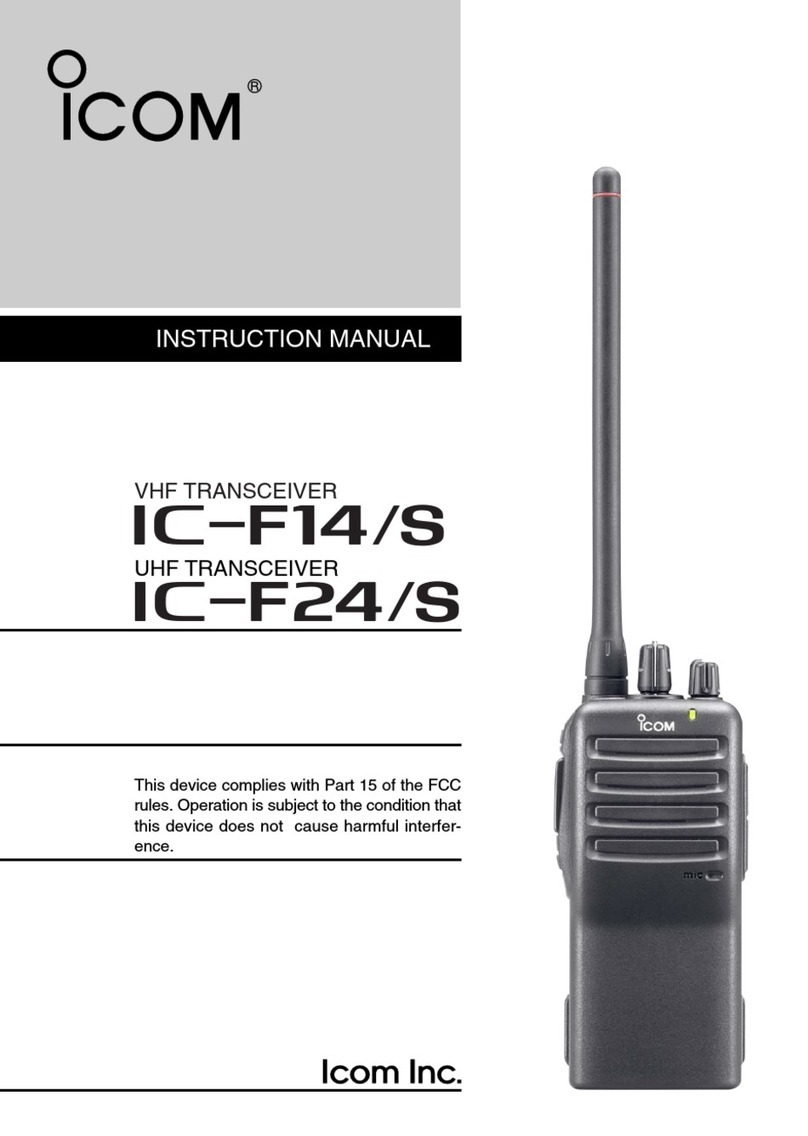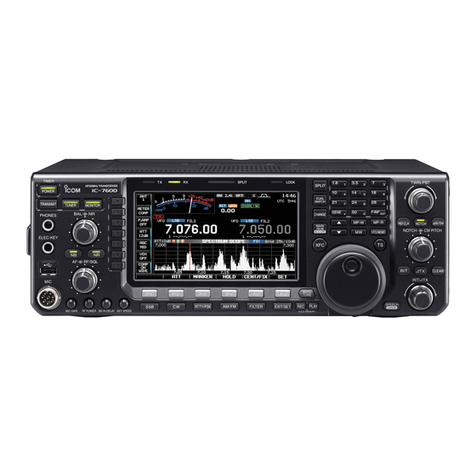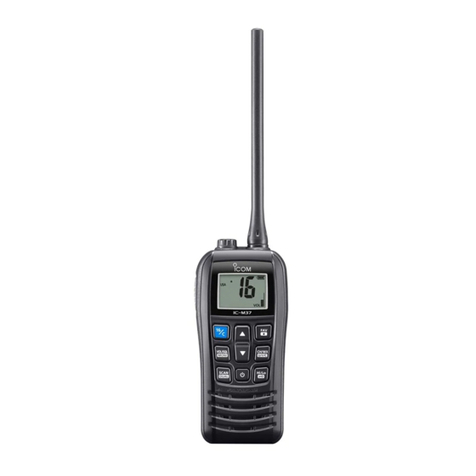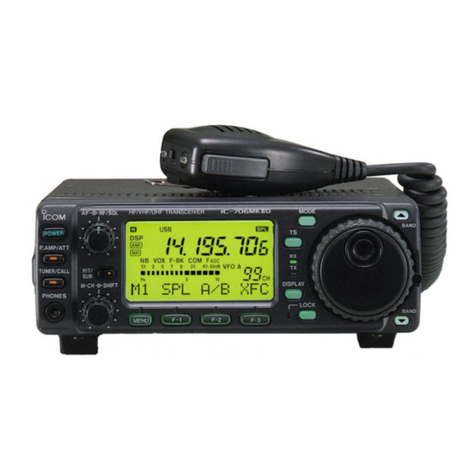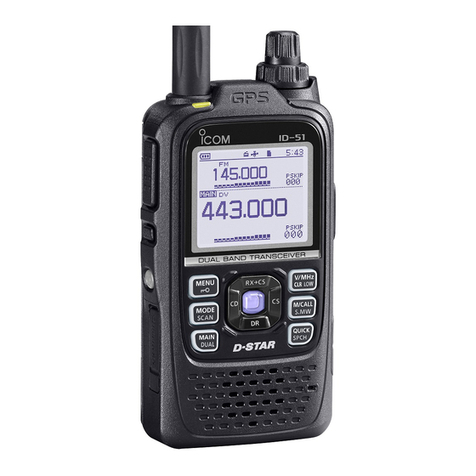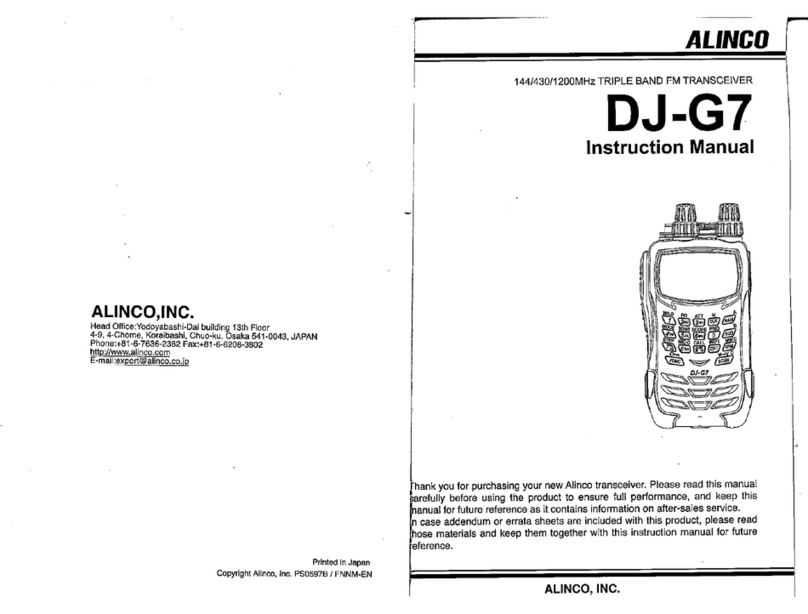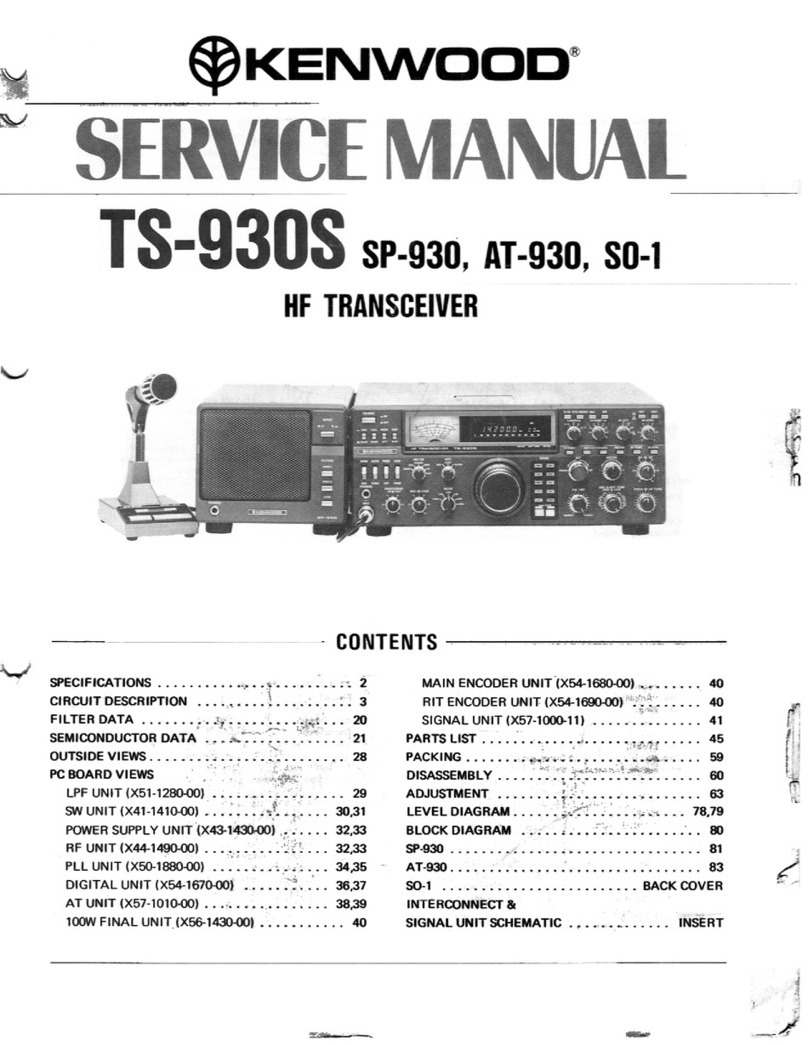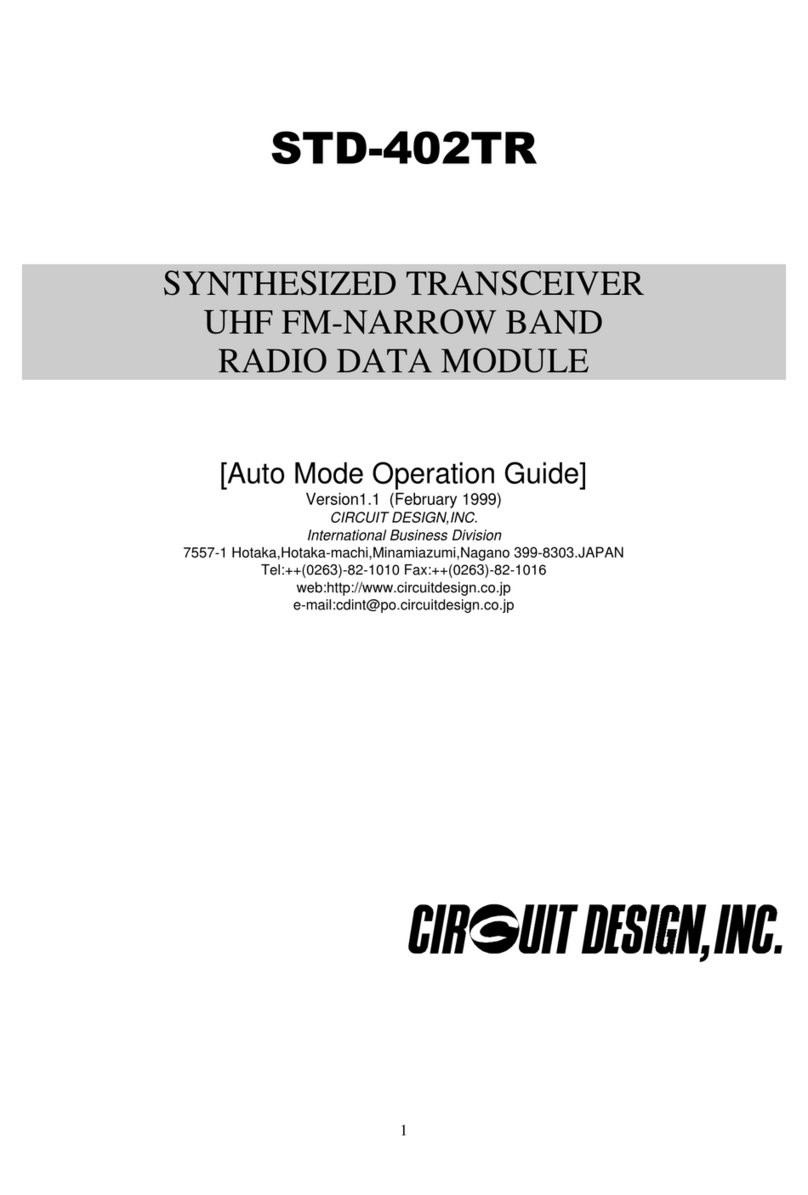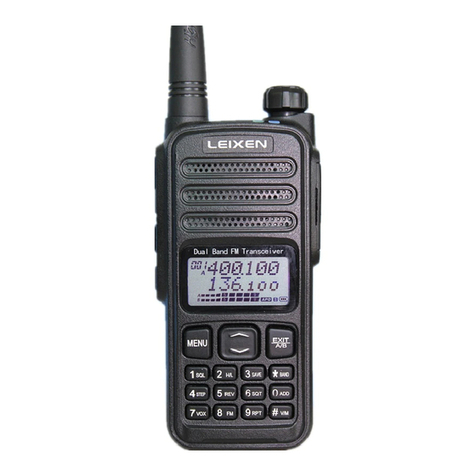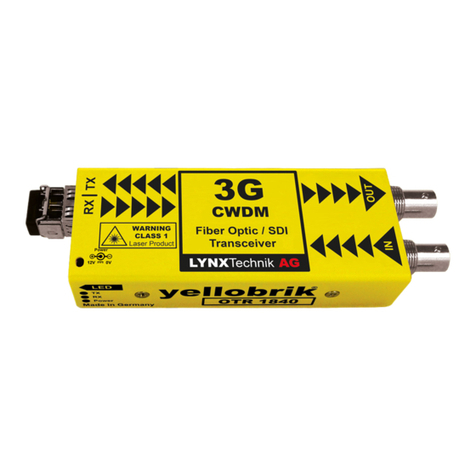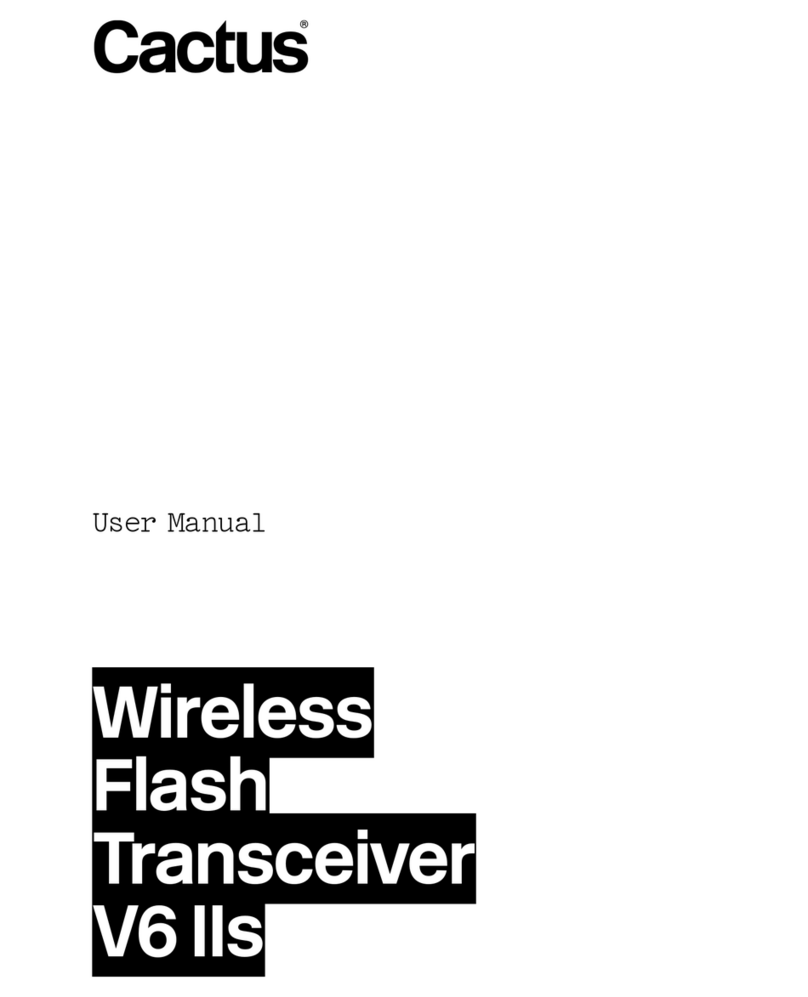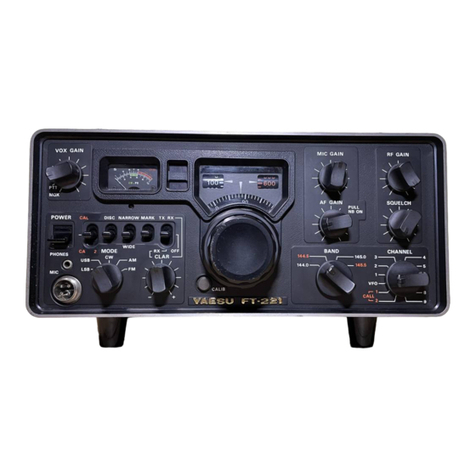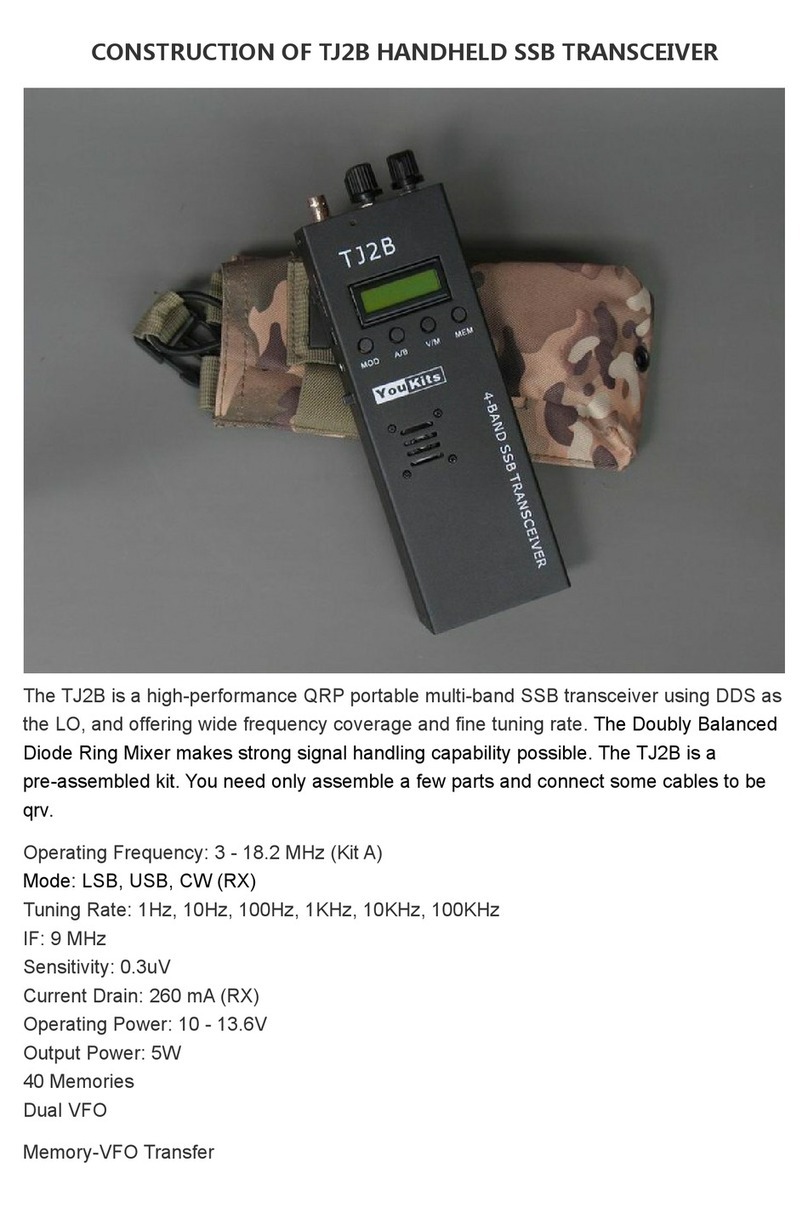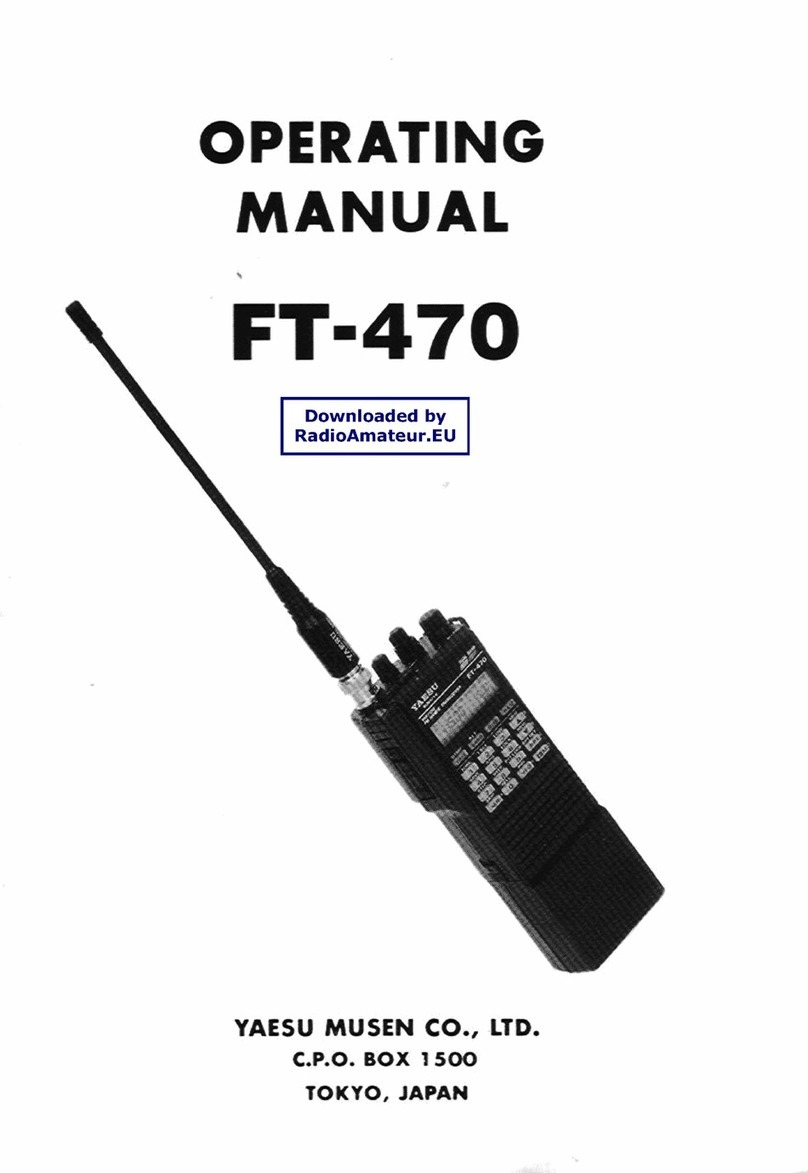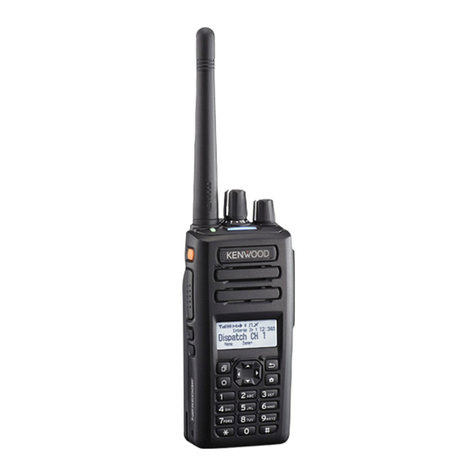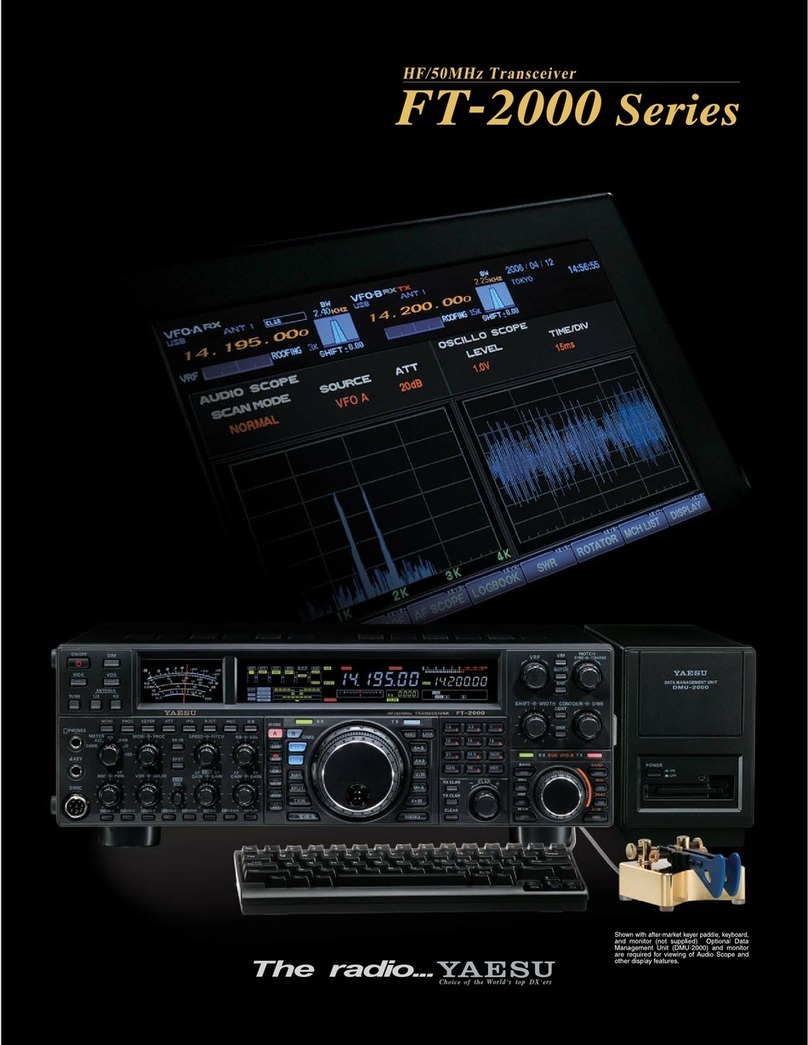Icom IC-F3061T Building instructions

S-14223HZ-C1-w
Mar. 2008
VHF TRANSCEIVER

This service manual describes the latest service information
for the IC-F3061/62/63/T/S, IC-F3161/62/63/T/S and
IC-F3163DT/DS VHF TRANSCEIVER at the time of
publication.
NEVER connect the transceiver to an AC outlet or to a DC
power supply that uses more than 7.2 V. This will ruin the
transceiver.
DO NOT expose the transceiver to rain, snow or any liquids.
DO NOT reverse the polarities of the power supply when
connecting the transceiver.
DO NOT apply an RF signal of more than 20 dBm (100 mW) to
the antenna connector. This could damage the transceiver’s
front-end.
To upgrade quality, any electrical or mechanical parts and
internal circuits are subject to change without notice or
obligation.
Be sure to include the following four points when ordering
replacement parts:
1. 10-digit Icom parts numbers
2. Component name
3. Equipment model name and unit name
4. Quantity required
<ORDER EXAMPLE>
5030002830 LCD M4-0078TAY-2 IC-F3061T Front unit 5 pieces
8810009220 Screw
PH B0 M2×8 ZK (BT)
IC-F3061T Chassis 10 pieces
Addresses are provided on the inside back cover for your
convenience.
Icom, Icom Inc. and logo are registered trademarks of Icom Incorporated (Japan) in the United States, the United
Kingdom, Germany, France, Spain, Russia and/or other countries.
ORDERING PARTS
1. Make sure the problem is internal before disassembling
the transceiver.
2. DO NOT open the transceiver until the transceiver is
disconnected from its power source.
3. DO NOT force any of the variable components. Turn
them slowly and smoothly.
4. DO NOT short any circuits or electronic parts. An
insulated tuning tool MUST be used for all adjustments.
5. DO NOT keep power ON for a long time when the
transceiver is defective.
6. DO NOT transmit power into a Standard Signal
Generator or a Sweep Generator.
7. ALWAYS connect a 50 dB to 60 dB attenuator between
the transceiver and a Deviation Meter or Spectrum
Analyzer when using such test equipment.
8. READ the instructions of test equipment throughly
before connecting a test equipment to the transceiver.
REPAIR NOTES
INTRODUCTION
CAUTION
MODEL SYMBOL CHANNEL
SPACING
KEY
PAD
Etc.
IC-F3061T [USA-01] 15.0/30.0 kHz
10-key
–
IC-F3063T [GEN-01] 12.5/25.0 kHz
IC-F3062T [EUR-01] 12.5/20.0/25.0
kHz
IC-F3061S [USA-01] 15.0/30.0 kHz
4-key
IC-F3063S [GEN-01] 12.5/25.0 kHz
IC-F3062S [EUR-01] 12.5/20.0/25.0
kHz
IC-F3062S [FRG-01] 20.0 kHz BOS
compatible
IC-F3161T [USA-01] 15.0/30.0 kHz
10-key
MDC
compatible
IC-F3163T [EXP-01] 12.5/25.0 kHz
IC-F3162T [EUR-01] 12.5/20.0/25.0
kHz
IC-F3161S [USA-01] 15.0/30.0 kHz
4-key
IC-F3163S [EXP-01] 12.5/25.0 kHz
IC-F3162S [EUR-01] 12.5/20.0/25.0
kHz
IC-F3161DT [USA-01] 6.25/15.0/30.0
kHz
10-key UT-126H
pre-installed
IC-F3161DS 4-key
(IC-F3061T)

CONTENTS
SECTION 1 SPECIFICATIONS
SECTION 2 INSIDE VIEWS
SECTION 3 DISASSEMBLY INSTRUCTIONS
SECTION 4 OPTIONAL UNIT INSTALLATION
SECTION 5 CIRCUIT DESCRIPITON
5-1 RECEIVER CIRCUITS. . . . . . . . . . . . . . . . . . . . . . . . . . . . . . . . . . . . . . . . . . . . . . . . . . . . . . . . 5-1
5-2 TRANSMITTER CIRCUITS . . . . . . . . . . . . . . . . . . . . . . . . . . . . . . . . . . . . . . . . . . . . . . . . . . . . 5-2
5-3 PLL CIRCUITS. . . . . . . . . . . . . . . . . . . . . . . . . . . . . . . . . . . . . . . . . . . . . . . . . . . . . . . . . . . . . . 5-3
5-4 POWER SUPPLY CIRCUITS. . . . . . . . . . . . . . . . . . . . . . . . . . . . . . . . . . . . . . . . . . . . . . . . . . . 5-4
5-5 PORT ALLOCATIONS . . . . . . . . . . . . . . . . . . . . . . . . . . . . . . . . . . . . . . . . . . . . . . . . . . . . . . . . 5-5
SECTION 6 ADJUSTMENT PROCEDURES
6-1 PREPARATION . . . . . . . . . . . . . . . . . . . . . . . . . . . . . . . . . . . . . . . . . . . . . . . . . . . . . . . . . . . . . 6-1
6-2 FREQUENCY ADJUSTMENT . . . . . . . . . . . . . . . . . . . . . . . . . . . . . . . . . . . . . . . . . . . . . . . . . . 6-4
6-3 TRANSMIT ADJUSTMENT . . . . . . . . . . . . . . . . . . . . . . . . . . . . . . . . . . . . . . . . . . . . . . . . . . . . 6-5
6-4 RECEIVE ADJUSTMENT . . . . . . . . . . . . . . . . . . . . . . . . . . . . . . . . . . . . . . . . . . . . . . . . . . . . . 6-6
SECTION 7 PARTS LIST
SECTION 8 MECHANICAL PARTS AND DISASSEMBLY
SECTION 9 BOARD LAYOUTS
SECTION 10 BLOCK DIAGRAM
SECTION 11 VOLTAGE DIAGRAM
SECTION 12 BC-160 (Optional)

1 - 1
SECTION 1 SPECIFICATIONS
[USA], [GEN], [EXP] [EUR], [FRG]
GENERAL
• Frequency coverage 136–174 MHz
• Type of emission Wide 16K0F3E (25.0 kHz/30.0 kHz) 16K0F3E (25.0 kHz) [EUR-01]
Middle – 14K0F3E (20.0 kHz) [EUR-01], [FRG-01]
Narrow
11K0F3E, 11K0F7E/D* (15.0 kHz)
8K50F3E, 8K10F1E/D* (12.5 kHz)
4K00F1E/D* (6.25 kHz)
8K50F3E (12.5 kHz) [EUR-01]
4K00F1E/D* (6.25 kHz) [EUR-01]
• Number of programable channels 512 channels (128 zones)
• Antenna impedance 50 Ω(nominal)
• Operating temperature range −22˚F to +140˚F –25˚C to +55˚C
• Power supply requirement Specified Icom's battery packs only (Operatable voltage; 7.2 V DC negative ground)
• Current drain
(approx.) RX Stand-by 100 mA
150 mA (with UT-119H/UT-126H)
Max.audio 600 mA
TX at 5 W 1.5 A
at 1 W 0.7 A
• Dimensions (with BP-232N, approx.) 2 3/32 (W) × 5 11/32 (H) × 1 17/32 (D) in 53.0 (W) × 136.0 (H) × 38.5 (D) mm
• Weight (with BP-232, approx.) 12 oz 340 g
TRANSMITTER
• Transmit output power 5 W (High), 2 W (Low2), 1 W (Low1)
• Modulation Variable reactance frequency modulation
• Max. frequency deviation Wide ±5.0 kHz
Middle – ±4.0 kHz
Narrow ±2.5 kHz
• Frequency error ±1.0 ppm ±1.5 kHz
• Spurious emission 75 dB typ. 0.25 μW (≤1 GHz), 1.00 μW (>1 GHz)
• Adjacent channel power Wide More than 70 dB (80 dB typ.)
Middle – More than 70 dB (80 dB typ.)
Narrow More than 60 dB (70 dB typ.)
• Audio harmonic distortion 3% typ. (with 1 kHz AF 40% deviation)
• FM hum and noise
(without CCITT filter)
Wide More than 40 dB (46 dB typ.) –
Narrow More than 34 dB (40 dB typ.) –
• Limiting charact of modulation 60–100% of max. deviation
• Microphone impedance 2.2 kΩ
RECEIVER
• Receive system Double conversion superheterodyne
• Intermediate frequencies 1st IF; 46.35 MHz, 2nd IF; 450 kHz
• Sensitivity 0.25 μV typ. at 12 dB SINAD − 4 dBμV (EMF) typ. at 20 dB SINAD
• Squelch sensitivity (at threshold) 0.25 μV typ.
• Adjacent channel
selectivity
Wide More than 70 dB (75 dB typ.)
Middle − More than 70 dB (75 dB typ.)
Narrow More than 65 dB (68 dB typ.)
• Spurious response More than 70 dB
• Intermodulation More than 70 dB (74 dB typ.) More than 65 dB (67 dB typ.)
• Hum and Noise
(without CCITT filter)
Wide More than 40 dB (46 dB typ.) −
Narrow More than 34 dB (40 dB typ.) −
• Residual modulation
(with CCITT filter)
Wide − More than 45 dB (55 dB typ.)
Middle − More than 43 dB (53 dB typ.)
Narrow − More than 40 dB (50 dB typ.)
• Audio output power 0.5 W typ. at 5% distortion with an 8 Ωload
• Audio output impedance 8 Ω
*; Optional digital unit is necessary.
Specifications are measured in accordance with EIA-152-C/204D, TIA-603 (for [USA], [GEN], [EXP]) or EN 300 086 (for [EUR], [FRG]).
All stated specifications are subject to change without notice or obligation.

2 - 1
SECTION 2 INSIDE VIEWS
AF power amplifier
controller
Q501: 2SB1132
Q502: XP6501
Expander IC
(IC506: M62320FP)
Expander IC
(IC505: M62320FP)
AF power amplifier
(IC508: TDA8547TS)
Mic selector
Q506: UNR9113J
Q516: UNR9213J
Speaker selector
(Q512, Q513: UNR9213J)
APC amplifier
(IC601: TA75S01F)
TX power detector
(D604: RB706F-40)
TX power amplifier
(Q601: RD07MVS1)
TX/RX antenna
switch circuit
TX power detector
(D605: RB706F-40)
RF amplifier
(Q10: 3SK293)
D/A converter
(IC20: M62334FP)
Mixer
(Q37: 3SK324)
ALC amplifier
(IC15: AN6123MS)
FM IF IC
(IC3: TA31136FNG)
1st IF amplifier
(Q25: 2SC4215)
CPU 5V regulator
(IC6: NJM2870)
PLL IC
(IC1: LMX2352TM)
D/A converter
(IC4: M62364FP)
DTMF decoder
(IC10: BU8872FS)
CPU
(IC18: HD64F2268TF20V)
• FRONT UNIT • RF UNIT (Top view)
• RF UNIT (Bottom view)
• MAIN UNIT (Top view) • MAIN UNIT (Bottom view)

3 - 1
SECTION 3 DISASSEMBLY INSTRUCTION
• REMOVING THE CHASSIS UNIT
1Unscrew 1 nut A, and remove 2 knobs Band C.
2Unscrew 2 screws D.
3Take off the chassis unit in the direction of the arrow.
4Disconnect the flat cable Eform J501.
5Remove the seal F.
6Unscrew 2 nuts Gand remove the plate H.
FD
H
G
A
B
C
E
Chassis unit
J501
• REMOVING THE MAIN UNIT
1Unsolder 1 point A.
2Unscrew 1 screw Band remove the VR unit.
3Unsolder 5 points Cand remove the shield plate D.
4Unsolder 10 points E.
5Unscrew 7 screws Fand remove the MAIN unit from the
chassis.
D
C5
A
F
E10
FF
B
VR unit
MAIN unit
• REMOVING THE RF UNIT
1Unsolder 3 points A.
2Unscrew 4 screws Band remove the RF unit from the
chassis.
A
A
B
RF unit
• REMOVING THE FRONT UNIT
1Disconnect the flat cable Afrom J503.
2Unsolder 2 points B.
3Unscrew 6 screws Cand remove the plate Dand FRONT
unit.
A
C
C
C
C
D
B
FRONT unit
J503

4 - 1
SECTION 4 OPTIONAL UNIT INSTALLATION
CAUTION! Optional unit installation should be done at authorized Icom servise center only.
The waterproof capability of the transceiver cannot be guaranteed if you install an unit yourself, or have it done at
a non-authorised dealer/service center.
A
BC
D
Install the optional unit as follows.
qRotate [VOL] to turn the power OFF, and remove the battery pack.
wRemove the anntena and antenna nut A.
eRemove the rotary selector B and volume control C.
rUnscrew two screws D, then take off the chassis from the front panel in the direction of the arrow.
BE CAREFUL! Flat cable is connected between the MAIN unit on the chassis and front panel.
t Install the optional unit as below.
J1
• UT-96R, UT-109R and UT-110R installation* • UT-119H and UT-126H installation
*;The following PC bord modification is required when installing optional UT-109R and UT-110R.
Re-solder
NOTE: When uninstalling the unit
Be sure to re-solder the disconnected
points as below when you remove the
unit. Otherwise, no TX modulation or AF
output is available.
Cut the pattern on the PC board at "MIC" and "AFOUT" as shown below.
MIC
AFOUT
DO NOT attach the unit
to the connector "J2."
Otherwise no TX modu-
lation or AF output is
available.
DO NOT attach the unit
to the connector "J1."
Otherwise no TX modu-
lation or AF output is
available.

SECTION 5 CIRCUIT DESCRIPTION
5-1 RECEIVER CIRCUITS
5-1-1 ANTENNA SWITCH (MAIN and RF UNITS)
The received signals from the antenna connector are passed
through the antenna switch which toggles the receive (RX) line
and transmit (TX) line.
The received signals from the antenna connector are passed
through the low-pass filter (LPF; L601−L603, C601, C602, C604
−C606, C608, C609, C663), and the antenna switch (D601 and
D603 are OFF).
While transmitting, the voltage on the T5V line is applied
to D601 and D603, and these are ON. Thus the TX line is
connected to the antenna. Simultaneously, the RX line is
connected to the GND to prevent transmit signal entering.
While receiving, no voltage is applied to the D601 and D603, and
these are OFF. Thus the TX line and the antenna is disconnected
to prevent received signals entering. Simultaneously, the RX
line is disconnected from the GND and the received signals are
passed through the LPF (RF UNIT; L604, C611, C612, MAIN
UNIT; L29, C117).
The filtered signals from the LPF (RF UNIT; L604, C611, C612,
MAIN UNIT; L29, C117) are then applied to the RF circuit via the
two staged tunable bandpass filter (BPF; D23, D24, L31, L32,
C120−C122, C125−C127).
5-1-2 RF CIRCUIT (MAIN UNIT)
The received signals are filtered and amplified at the RF
circuit.
The filtered signals are applied to the RF amplifier (Q10). The
amplified signals are applied to the 1st mixer (Q37) via another
two-staged BPF (D28, D29, L33, L34, C140−C144, C147).
5-1-3 1st IF CIRCUITS
The received signals are converted into the 1st IF signal, and
amplified at the 1st IF circuits.
The filtered signals from the RF circuit are converted into the
46.35 MHz 1st IF signal by being mixed with the 1st Local
Oscillator (LO) signals from the VCO (155 MHz and below; Q1, D1
−D4, 155 MHz and higher; Q2, D5−D8) at the 1st mixer (Q37).
The converted 1st IF signal is passed through the 1st IF filter
(in wide mode; FI1, in narrow mode; FI4) via the bandwidth
switch (D34), to remove adjacent signals. The filtered signal
is applied to the 1st IF amplifier (Q25) via another bandwidth
switch (D35). The amplified 1st IF signal is then applied to the
FM IF IC (IC3, pin 16).
5-1-4 2nd IF AND DEMODULATOR CIRCUITS (MAIN UNIT)
The 1st IF signal is converted into the 2nd IF signal, and de-
modulated.
The 1st IF signal from the 1st IF amplifier (Q25) is applied to
the 2nd IF mixer in the FM IF IC (IC3, pin 6). And the 1st IF
signal is converted into the 450 kHz 2nd IF signal by being
mixed with the 2nd LO signal from the reference frequency
oscillator (X1) via the tripler (Q18).
The converted 2nd IF signal is output from pin 3, and passed
through the 2nd IF filter (FI2) to suppress sideband noise. In
narrow mode, the 2nd IF signal is also passed through another
2nd IF filter (FI3) via bandwidth switches (D32, D33).
The filtered 2nd IF signal is applied to the limiter amplifier in
the FM IF IC (IC3, pin 5). The amplified 2nd IF signal is FM-
demodulated at the quadrature detector (X5, IC3, pins 10, 11)
and output from pin 9. The demodulated AF signals are then
applied to the AF circuits.
5-1-5 AF CIRCUITS (FRONT and MAIN UNITS)
The demodulated AF signals from the FM IF IC are amplified
and filtered at AF circuits. This transceiver employs the
base band IC for audio signal processing for both transmit
and receive. The base band IC is an audio processor and
composed of pre-amplifier, compressor, expander, scrambler,
etc. in its package.
The demodulated AF signals from the FM IF IC (IC3, pin 9) are
applied to the base band IC (IC5, 23) via the Digital/Analog
switch (IC14, pins 2, 15).
The applied AF signals are amplified at the amplifier (RXA1)
and level adjusted at the volume controller (VR3), then
suppressed unwanted 3 kHz and higher audio signals at LPF.
The filtered AF signals are applied or bypassed the TX/RX
HPF, scrambler, de-emphasis sections in sequence.
5 - 1
D/A converter
(IC4)
Mixer
RSSI
Quadrature
detector
2
1
1st IF signal from the IF amplifier (Q25)
16
Noise
detector
+5V
X5
1110
FM IF IC (IC3)
Filter
amp.
Limiter
amp.
Demodulated signals
to the AF circuits
• 2nd IF AND DEMODULATOR CIRCUITS
9
“NOIS” signal to the CPU (IC18: pin 37)
“RSSI” signal to the CPU (IC18: pin 50)
13
12
Q18
X1
15.3 MHz
45.9 MHz BPF
2
3
8735
FI2
FI3
N/W
SW
N/W
SW
D33 D32

The TX/RX HPF filters out 250 Hz and lower audio signals,
and the de-emphasis circuit obtains –6 dB/oct of audio
characteristics. The expander expands the compressed audio
signals and also noise reduction function is provided.
The AF signals are then level adjusted at the volume controller
(VR4) and amplified at the amplifier (RXA2). The amplified AF
signals are output from pin 20 and passed through another de-
emphasis circuit (IC13, pins 2, 15), and then applied to the D/
A converter (IC4, pin 16) for level adjustment via the AF mute
switch (IC14, pins 3, 4).
The level-adjusted AF signals are applied to the AF amplifier
(FRONT UNIT; IC509, pin 2). The amplified AF signals are
output from pin 1, and applied to the AF power amplifier
(IC508, pin 17) to obtain 0.5 W of AF output power. The power-
amplified AF signals are output from pin 18, and then applied
to the internal speaker.
If an external speaker-microphone or headset is attached to
the multi-connector (JACK UNIT; MP801), the AF signals from
the AF amplifier (IC509, pin 1) are applied to the AF power
amplifier (IC508, pin 14). The power-amplified AF signals are
then output from pin 13, and applied to the multi-connector
(JACK UNIT; MP801).
5-1-5 SQUELCH CIRCUIT
• NOISE SQUELCH
The squelch mutes the AF output signals when no RF signals
are received. By detecting noise components (30 kHz and
higher signals) in the demodulated AF signals, the squelch
circuit toggles the AF power amplifier ON and OFF.
A portion of the demodulated AF signals from the FM IF IC
(IC3, pin 9) are applied to the D/A converter (IC4, pin 1) for
level adjustment (squelch threshold adjustment). The level-
adjusted AF signals are output from pin 2 and passed through
the noise filter (IC3, pins 7, 8, R121−R124, C216−C218). The
filtered noise signals are amplified the noise components only.
The amplified noise components are converted into the pulse-
type signal at the noise detector section, and output from pin 13
as the “NOIS” signal. The signal is applied to the CPU (IC18, pin
37). Then the CPU outputs serial data to the expand IC (FRON
UNIT; IC505, pin 3), and the expand IC outputs “AFON” signal
from pin 4 according to the “NOIS” signal level, to the AF power
amplifier controller (FRONT UNIT; Q501, Q502, D508). The AF
power amplifier controller toggles AF power amplifier (FRONT
UNIT; IC508) ON and OFF according to the "AFON" signal.
• TONE SQUELCH
The tone squelch circuit detects tone signals and opens the
squelch only when receiving a signal containing a matched
sub audible tone. When the tone squelch is in use, and a
signal with a mismatched or no sub audible tone is received,
the tone squelch circuit mutes the AF signals even when the
noise squelch is open.
• CTCSS/DTCS
A portion of the demodulated AF signals are passed through
the active LPF (Q28) to filters CTCSS/DTCS signal. The filtered
signal is applied to the CPU (IC18, pin 46). The CPU compares
the applied signal and the set CTCSS/DTCS, then output the
serial data to the expand IC (FRON UNIT; IC505, pin 3), and
the expand IC outputs “AFON” signal from pin 4 to the AF
power amplifier controller (Q501, Q502, D508).
• 2/5 TONE
2/5 tone signals in the demodulated AF signals are passed
through the LPF in the base band IC (IC5) and output from
pin 21, then applied to the CPU (IC18, pin 45) and decoded.
• DTMF
DTMF signals in the demodulated AF signals are passed through
the LPF in the base band IC (IC5) and output from pin 21, then
applied to the DTMF decoder (IC10, pin 1) and decoded.
5-2 TRANSMITTER CIRCUITS
5-2-1 MICROPHONE AMPLIFIER CIRCUITS (MAIN UNIT)
The AF signals from the microphone (MIC signals) are filtered
and level-adjusted at microphone amplifier circuits.
MIC signals from the microphone are passed through the
microphone switch (FRON UNIT; Q515). The microphone
switch selects the AF signals from the internal microphone
(FRON UNIT; MC1) or from an external microphone.
MIC signals from the microphone switch (FRON UNIT; Q515)
are applied to the microphone amplifier (FRON UNIT; IC509,
pin 6), and amplified AF signals are output from pin 7, and
passed through the pre-emphasis circuit (IC13, pins 4, 5)
to obtain +6 dB/oct of frequency characteristic. The pre-
emphasized MIC signals are then applied to the microphone
amplifier (IC9, pin 9). And the amplified MIC signals are output
from pin 8, and applied to the D/A converter (IC4, pin 9) for
level adjustment (=microphone sensitivity adjustment). The
level-adjusted MIC signals are output from pin 10, and applied
to the ALC (Automatic Level Control) circuit (IC15, pin 3)
which limits the amplitude of the MIC signals to prevent over
deviation. The amplitude-limited MIC signals are output from
pin 5, then applied to the base band IC (IC5, pin 3).
The applied MIC signals are amplified at the amplifier (TXA1),
and level adjusted at the volume controller (VR1). The level
adjusted MIC signals are applied or bypassed the compressor
section, pre-emphasis section, TX/RX HPF, de-scrambler, limiter,
splatter, in sequence, then applied to another volume controller.
The compressor compresses the MIC signals to provide high S/N
ratio for receive side, and the pre-emphasis obtains +6 dB/oct
audio characteristics. The TX/RX HPF filters out 250 Hz and
lower audio signals, the limiter limits its level and the splatter
filters out 3 kHz and higher audio signals.
The filtered MIC signals are level adjusted at another volume
controller (VR2), and then output from pin 7 via smoothing
filter (SMF).
5 - 2
Scrambler/
De-scrambler
TX/RX
HPF
Pre-
emphasis Limiter Splatter VR2
Expander VR4
RXA2
SMF
De-
emphasis
Com-
pressor
VR1
(HPF)
RX
LPF
VR3
(HPF)
7 MOD
18
19
20 SIGNAL
3TXIN
• BASE BAND IC BLOCK DIAGRAM
23RXIN
21SDEC
TXA1
RXA1
BASE BAND IC (IC5)

Power
amp.
ALC
amp.
Drive
amp.
+
–
HV
“ISENS”
• APC CIRCUIT
to the anntena
“T2”
“TMUT”
from TX/RX switch
(MAIN UNIT; D14, D15)
T5V
Q604, Q605
Q602
Pre-
drive
amp.
Q603
IC601
Q601
to the receive circuits
LPF LPF
ANT
SW
Current
detector
D604
Power detecter
D605
Q606
The output AF signals are then passed through the Digital/
Analog switch (IC14, pins 12, 14) and applied to the AF mixer
(IC9, pin 6) where the MIC signals and Tone signals are mixed
with (while CTCSS/DTCS are in use) via the PM/FM switch
(IC13, pins 12, 14).
The CTCSS and DTCS signals are generated by the CPU
(IC18) and output from pins 89−91. The output signals are
passed through the 3 registers (R263–R265) to change its wave
form. The wave form changed CTCSS/DTCS signals are passed
through the LPF (IC17, pins 1, 3) and the D/A converter (IC4,
pins 21, 22) for level adjustment. The level adjusted CTCSS/
DTCS signals are then applied to the AF mixer (IC9, pin 6).
2/5 tone and DTMF signals are generated by the CPU (IC18)
and output from pin 43. The output signals are passed through
two LPF's (IC17, pins 8, 10 and pins 5, 7), then applied to the AF
mixer (IC9, pin 6).
The mixed AF signals are output from pin 7 of the AF mixer
(IC9) and passed through the D/A converter (IC4, pins 3, 4)
for level adjustment (=deviation adjustment), then applied to
the modulation circuit (D9) as the modulation signals. The
modulation signals are also applied to the reference frequency
oscillator (X1) via D/A converter (IC4, pins 11, 12) and AF
amplifier (IC21, pins 1, 4).
5-2-2 MODULATION CIRCUIT (MAIN UNIT)
The modulation signals from the microphone amplifier circuits
are applied to the D9, and modulate the VCO oscillating
signal by changing the reactance of D9. The modulated VCO
output signal is buffer-amplified by Q4 and Q6, then applied to
transmit amplifiers as a transmit signal via the TX/RX switch
(D14 is ON, D15 is OFF).
5-2-3 TRANSMIT AMPLIFIERS (RF UNIT)
The transmit signal from the TX/RX switch (MAIN UNIT; D14
is ON, D15 is OFF) is amplified to the transmit output level by
pre-driver (Q603), driver (Q602) and power (Q601) amplifiers.
The power-amplified transmit signal is passed through the
two LPF’s (L607, L608, C620, C622−C624, C664 and L606,
C615−617) to filter off the harmonic components in the
transmit signal. The filtered transmit signal is passed through
the antenna switching circuit (D601 and D603 are ON), then
applied to the antenna connector (CHASSIS; J1) via another
LPF (L601−L603, C601, C602, C604−C606, C608, C609, C663).
5-2-4 APC CIRCUIT (RF UNIT)
The APC (Automatic Power Control) circuit stabilizes transmit
output power to prevent the transition of the transmit output
power level which is caused by load mismatching or heat
effect, etc. The APC circuit also selects transmit output power
from high, middle and low power.
A portion of the transmit signal is detected by the transmit power
detector (D604, D605) to produce a DC voltage corresponding to
the transmit output power level. The detected voltage is applied
to the APC amplifier (IC601, pin 3). The transmit power setting
voltage “T2” from the D/A converter (MAIN UNIT; IC20, pin 2) is
applied to another input terminal (pin 1) as the reference voltage.
The APC amplifier compares the detected voltage and reference
voltage, and the difference of the voltage is output from pin 4.
The output voltage controls the bias of the drive (Q602) and
power (Q601) amplifiers to reduce/increase the gain of these
amplifiers for stable transmit output power.
The change of transmit output power is carried out by the
change of reference voltage "T2," and the transmit power
muting is carried out by the TX mute switch (Q606), using the
“TMUT” signal from the CPU (IC18, pin 13).
5-2-4 OVER CURRENT DETECTION CIRCUIT (RF UNIT)
The driving current of the drive (Q602) and power (Q601)
amplifiers is detected at the current detector (Q604, Q605)
by detecting the difference of voltage between both terminals
of R623. The detected voltage "ISENS" is applied to the CPU
(IC18, pin 47).
In case of the over current, the CPU outputs "TMUT" signal
from pin 13 to TX mute switch (Q606) to stop the transmitting
for protection of transmit amplifiers (Q601, Q602).
5-3 PLL CIRCUITS
5-3-1 VCO (Voltage Controlled Oscillator) CIRCUITS
(MAIN UNIT)
A VCO is a oscillator which its oscillating frequency is
controlled by adding voltage (lock voltage).
This transceiver has 3 VCO’s; RX VCO1 (Q1, D1−D4), RX
VCO2 (Q2, D5−D8) and TX VCO (Q3, D10−D12). The RX
VCO1 oscillates the 1st LO signals for 155 MHz and higher,
and the RX VCO2 oscillates the 1st LO signals for 155 MHz
and lower frequencies. And the TX VCO oscillates the transmit
output signal.
• RX VCO1 and RX VCO2
The RX VCO1/RX VCO2 (Q1, D1−D4/Q2, D5−D8) oscillates
the 1st LO signals. The output signals are amplified by the
buffer amplifiers (Q4, Q6), and applied to the 1st mixer (Q37)
via TX/RX switch (D14 is OFF, D15 is ON) and LPF (L38,
L39, C161−C164, C383, C384), to be mixed with the received
signals to produce the 46.35 MHz 1st IF signal.
• TX VCO
The TX VCO (Q3, D10−D12) oscillates the transmit signal.
The output signal is applied to the transmit amplifiers via the
buffer amplifiers (Q4, Q6) and TX/RX switch (D14 is ON, D15
is OFF).
5 - 3

Loop
filter
X1
15.3 MHz
Q2, D5–D8
RX VCO2 (136–155 MHz)
Q1, D1–D4
RX VCO1 (155–174 MHz)
TX VCO
Q3, D10–D12
PLL control signals from the CPU (IC18)
PLL unlock signal
to the CPU (IC18, pin 73)
15.3 MHz
reference frequency signal
• PLL CIRCUIT
Buffer
Q4
Buffer
Q6
Buffer
Q5
to transmitter circuit
to 1st mixer circuit
D15
D14
BPF
PLST
SSO
SCK
4
11
6
10
14
15
16
PLL IC (IC1)
Shift register
Prescaler
Phase
detector
Divide
ratio
adjustment
Charge
pump
Programmable
divider
Reference
divider
#056
REGURATOR
6
REGURATOR
62%&
REGURATOR
36
REGURATOR
46
REGURATOR
26
REGURATOR
0OWERSWITCH
11
111
)#
)#
1
1
1
(6
6##
#056
#05
6
62%&
36 h3#v
6OLTAGELINE
#ONTROLSIGNAL
h4#v
h2#v
46
2ECEIVERCIRCUITS
!TTACHEDOPTIONALUNITS
!&LIFIERCONTROLLER
&2/.45.)411$
ETC
#05)#
%%02/-)#
ETC
0,,)#)#
"ASEBAND)#)#
ETC
0,,)#)#
4RANSMITTERCIRCUITS
26
48POWERAMPLIFIERS
2&5.)411
2&5.)4
112
#URRENT
SENSOR
)#
!TTACHEDOPTIONALUNITS
$!CONVERTERS
ETC
"ATTERYPACK
A portion of the each VCO output is applied to the PLL IC (IC1,
pin 6) via the buffer amplifiers (Q4, Q5) and the tunable BPF
(D30, D31, L40, C170−C174).
5-3-2 PLL CIRCUIT (MAIN UNIT)
The PLL circuit provides stable oscillation of the transmit frequency
and receive 1st LO frequency. The PLL output frequency is
controlled by the divided ratio (N-data) from the CPU.
The buffer-amplified VCO output signals from the tunable BPF
(D30, D31, L40, C170−C174) are applied to the PLL IC (IC1,
pin 6). The applied signals are divided at the prescaler and
programmable counter according to the “SSO” signal from the
CPU (IC18, pin 10). The divided signal is phase-compared with
the reference frequency signal from the reference frequency
oscillator (X1), at the phase detector.
The phase difference is output from pin 4 as a pulse type signal
after being passed through the internal charge pump. The output
signal is converted into the DC voltage (lock voltage) by passing
through the loop filter (R7, R9, R12, C17, C18, C20). The lock
voltage is applied to the variable capacitors (D1 and D2 of RX
VCO1, D7 and D8 of RX VCO2, D11 and D12 of TX VCO) and
locked to keep the VCO frequency constant.
If the oscillated signal drifts, its phase changes from that of
the reference frequency, causing a lock voltage change to
compensate for the drift in the VCO oscillating frequency.
5-4 POWER SUPPLY CIRCUITS (MAIN UNIT)
Voltage from the attached battery pack is routed to whole of the circuit in the transceiver via switches and regulators.
5 - 4

5-5 PORT ALLOCATIONS
5-5-1 CPU (MAIN UNIT; IC18)
Pin
No.
Port
Name Description
1 DSDA Outputs serial data to the D/A converter (IC20, pin 6).
2 DAST Outputs strobe signal to the D/A converter (IC4, pin 6).
3 SIDE3 Input port for [Side3] key (S4).
"Low"=When the key is pushed.
4−7 CBI0−3 Input ports for [ROTARY SELECTOR] (VR UNIT; S701).
10 SSO Outputs serial data to the PLL IC (IC1, pin 15), D/A
converter (IC4, pin 8).
11 SCK Outputs serial crock signal to the PLL IC (IC1, pin
14), D/A converter (IC4, pin 8).
13 PLST Outputs PLL strobe signal to the PLL IC (RF UNIT;
IC1, pin 16).
15 DASW Outputs mode (Digital/Analog) switching signal to
the D/A converter (IC14, pins 10, 11).
17 TMUT Outputs transmit mute signal to the transmit mute
switch (RF UNIT; Q606).
18 NWC2 Outputs Narrow/Wide mode switching signal to the
bandwidth switches (Q26, D32, D33).
19 NWC1 Outputs Narrow/Wide mode switching signal to the
bandwidth switches (Q27, Q41, Q42, D34, D35).
20 DDSD Outputs serial data to the DTMF decode IC (IC10,
pin 9).
21 DDAC Outputs serial clock signal to the DTMF decode IC
(IC10, pin 11).
26 T5C
Outputs T5V line control signal to the T5V regulator
(Q15).
"Low"= While transmitting.
27 R5C
Output R5V line control signal to the R5V regulator
(Q16).
"Low"= While receiving.
28 S5C
Output S5V line control signal to the S5V regulator
(Q14).
"Low"=While power save mode.
29 PTTSW Input port for [PTT] switch (S3).
"Low"=When the switch is pushed.
30 SIDE2 Input port for [Side2] key (S5).
"Low"=When the key is pushed.
32 RMUT Outputs mute signal to the AF mute switch (D42).
37 NOIS Input port for the noise level from the FM IF IC (IC3,
pin 13).
38 POSW Input port for power switch (VR UNIT; R702) from
power controller (D36).
39 DDST Outputs strobe signal to the DTMF decode IC (MAIN
UNIT; IC10, pin 14).
40 MTCK Outputs serial clock signal to the base band IC
(MAIN UNIT; IC5, pin 9).
41 PWON
Outputs VCC line control signal to the power switch
(Q30, Q31).
"Low"=While the power is ON.
43 SENC Outputs single tone encode signal to the LPF (IC17,
pin 10).
44 BEEP Outputs beep sound to the AF circuits (IC4, pin 13).
45 SDEC Input port for decoded 2/5 tone and DTMF signals.
46 CDEC Input port for decoded CTCSS/DTCS signal.
47 ISENS Input port for power amplifier current detect signal
from the current detector (RF UNIT; Q604, Q605).
48 BATV Input port for remaining battery power.
49 LVIN Input port for VCO lock voltage.
50 RSSI Input port for RSSI signal from the FM IF IC (IC3,
pin 12).
55 EMER Input port for [Emer] switch (VR UNIT; S702).
Pin
No.
Port
Name Description
70 CSFT Outputs CPU clock frequency shift signal to the CPU
clock oscillator (X2, D38).
71 DUSE Outputs CTCSS/DTCS select signal to the CTCSS/
DTCS switch (Q34).
73 UNLK Input port for PLL unlock detect signal from the PLL
IC (IC1, pin 11).
74 RLED Outputs RX indicator (VR UNIT; DS701) control
signal to the LED driver (VR UNIT; Q701).
75 TLED Outputs TX indicator (VR UNIT; DS701) control
signal to the LED driver (VR UNIT; Q701).
78 FSDA Outputs serial data to the expand IC (FRONT UNIT;
IC505, pin 3).
79 FSCL Outputs serial clock signal to the expand IC (FRONT
UNIT; IC505, pin 3).
81 CIRQ Input port for external connection detect signal from
J1 and J2.
88 SIDE1 Input port for [Side1] key (S6).
"Low"=When the key is pushed.
89−
91
CENC0−
2Output CTCSS/DTCS signals to the LPF (IC17, pin 3).
92 EMPH Outputs emphasis characteristic change signal to
the D/A converter (IC13, pins 9, 10).
93 MTDT Outputs serial data to the base band IC (IC5, pin 10).
96 MSCK Outputs serial clock signal to the base band IC
(MAIN UNIT; IC5, pin 13).
97 PMFM Outputs modulation mode switching signal to the
PM/FM switch (IC13, pin 11) .
98 ESDA Outputs serial data to the EEPROM (IC19, pin 5).
99 ESCL Outputs serial clock signal to the EEPROM (IC19,
pin 6).
100 RESL Input port for reset signal from the reset IC (IC8, pin 1).
5-5-2 D/A CONVERTER (MAIN UNIT; IC20)
Pin
No.
Port
Name Description
1T1
Outputs BPF tuning voltage to the tunable BPF (D23,
D24, L31, L32, C120−C122, C125−C127).
2T2
• While receiving
Outputs BPF tuning voltage to the tunable BPF
(D28, D29, L33, L34, C140−C144, C147).
• While transmitting
Outputs TX power setting voltage to the APC
amplifier (RF UNIT; IC601).
3 TXLVA Outputs oscillation frequency adjust voltage to the
TX VCO (Q3, D10−D12).
4 RXLVA Outputs oscillation frequency adjust voltage to the
RX VCO1/2 (Q1, D1−D4/Q2, D5−D8).
5-5-3 EXPAND IC (FRONT UNIT; IC505)
Pin
No.
Port
Name Description
4 AFON
Outputs AF power amplifier (Q508, Q509) control
signal to the AF power amplifier controller (Q501,
Q502, D508).
5 LIGH Outputs backlight control signal to the backlight
driver (Q507−Q509).
6 SPCON Outputs internal/external speaker select signal to
the SP/ESP switch (Q512, Q513).
7 MCON Outputs internal/external microphone select signal
to the microphone controller (Q505, D504).
5 - 5

SECTION 6 ADJUSTMENT PROCEDURES
▄REQUIRED TEST EQUIPMENTS
EQUIPMENT GRADE AND RANGE EQUIPMENT GRADE AND RANGE
Adjustment software
(Rev. 1.1 or later)
CS-F3060 ADJ (for F3060 series)
CS-F3160/5060 ADJ (for F3160 series) JIG cable modified OPC-966/U CLONING CABLE
FM deviation meter Frequency range
Measuring range
: DC–300 MHz
: 0 to ±10 kHz Attenuator Power attenuation
Capacity
: 20 or 30 dB
: 10 W
Frequency counter
Frequency range
Frequency accuracy
Sensitivity
: 0.1–300 MHz
: ±1 ppm or better
: 100 mV or better
Standard signal
generator (SSG)
Frequency range
Output level
: 0.1–300 MHz
: 0.1 µV to 32 mV
(–127 to –17 dBm)
RF power meter
Measuring range
Frequency range
Impedance
SWR
: 1–10 W
: 100–300 MHz
: 50 Ω
: Better than 1.2 : 1
Oscilloscope Frequency rang
Measuring range
: DC–20 MHz
: 0.01–20 V
External speaker Input impedance
Capacity
: 8 Ω
: 1 W or more
6 - 1
6-1 PREPARATION
▄SYSTEM REQUIREMENTS
• Microsoft®Windows®98/98SE/Me/2000/XP
• RS-232C serial port (D-sub 9 pin)
▄ADJUSTMENYT SOFTWARE INSTALLATION
qQuit all applications when Windows is running.
wInsert the CD into the appropriate CD drive.
eDouble-click the “Setup.exe” contained in the ‘CS-F3060
ADJ’ folder in the CD drive.
rThe “Welcome to the InstallShield Wizard for CS-F3060
ADJ” will appear. Click [Next>].
tThe “Choose Destination Location” will appear. Then click
[Next>] to install the software to the destination folder. (e.g.
C:\Program Files\Icom\CS-F3060 ADJ)
y
After the installation is completed, the “InstallShield Wiz-
ard Complete” will appear. Then click [Finish].
uEject the CD.
iProgram group ‘CS-F3060 ADJ’ appears in the ‘Programs’
folder of the start menu, and ‘CS-F3060 ADJ’ icon ap-
pears on the desk top screen.
▄BEFORE STARTING SOFTWARE ADJUSTMENT
Clone the adjustment frequencies into the transceiver, and
set the configuration using with the CS-F3060 CLONING SOFT-
WARE before starting the software adjustment. Otherwise, the
software adjustment can not be started.
CAUTION!: BACK UP the originally programmed mem-
ory data in the transceiver before program-
ming the adjustment frequencies.
When program the adjustment frequencies into
the transceiver, the transceiver’s memory data
will be overwritten and lose original memory
data at the same time.
Microsoft and Windows are registered trademarks of Micro-
soft Corporation in the U.S.A. and other countries.
▄STARTING SOFTWARE ADJUSTMENT
qConnect the transceiver and PC with OPC-966 JIG CABLE.
wTurn the transceiver power ON.
eBoot up Windows, and click the program group ‘CS-F3060
ADJ’ in the ‘Programs’ folder of the [Start] menu, then
CS-F3060 series ADJ’s window appears.
rClick ‘Connect’ on the CS-F3060 ADJ’s window, then appears
transceiver’s up-to-date condition.
tSet or modify adjustment data as specified.
• ADJUSTMENT FREQUENCY LIST
CH FREQUENCY ADJUSTMENT ITEM
1 154.900 MHz TX power
Mode
: Low1
: Narrow
2 173.900 MHz TX power
Mode
: Low1
: Narrow
3 136.100 MHz TX power
Mode
: Low1
: Wide
4 155.000 MHz TX power
Mode
: Low1
: Wide
5 155.000 MHz TX power
Mode
: Low2
: Wide
6 155.000 MHz TX power
Mode
: High
: Wide
7 155.000 MHz TX power
Mode
: Low1
: Narrow
8 136.100 MHz TX power
Mode
: Low1
: Narrow
9 173.900 MHz TX power
Mode
: Low1
: Narrow
10** 155.000 MHz TX power
Mode
: Low1
: Middle
11** 136.100 MHz TX power
Mode
: Low1
: Middle
12** 173.900 MHz TX power
Mode
: Low1
: Middle
13 155.000 MHz TX power
Mode
: Low1
: Wide
14 136.100 MHz TX power
Mode
: Low1
: Wide
15 173.900 MHz TX power
Mode
: Low1
: Wide
16* 155.000 MHz TX power
Mode
: Low1
: Digital
17* 136.100 MHz TX power
Mode
: Low1
: Digital
18* 173.900 MHz TX power
Mode
: Low1
: Digital
19 155.000 MHz
TX power
Mode
Tone
: Low1
: Widel
: CTCSS 151.4 Hz
20 136.100 MHz TX power
Mode
: Low1
: Wide
*;
Necessary only when the optional UT-119H or UT-126H is installed.
**; [F3062], [F3162] only.

6 - 2
FM
deviation meter Osciiloscope
to the antenna connector
Attenuator
20 dB or 30 dB
RF power meter
0.1–10 W/50 Ω
Frequency
counter
Standard signal generator
0.1 µV to 32 mV
(–127 dBm to –17 dBm)
CAUTION!
DO NOT transmit while
the SSG is connected to
the antenna connector
JIG CABLE
JIG CABLE
RS-232C cable
(straight)
PC
CAUTION: Attach the [SP
MIC] jack snugly, but do
not overtighten.
An overtightened jack will
damage the connector
pins in the transceiver.
OPC-966
(RS-232C type)
OPC-966U (USB type)
Add a jumper wire here
OPC-966U
(USB type Cloning cable)
+
GND
MIC
PTT
GND
GND
SP
PTT SWITCH
+−
AC MILLIVOLTMETER
(10 mV to 10 V)
AUDIO GENERATOR
(300–3000 Hz/1–500 mV)
+−
+−
4.7 µF
EXT. SPEAKER
(1 W/8 Ω)
PTT SWITCH
+
MICE
MIC
PTT
PTTE
Add a jumper wire here
OPC-966
(RS-232C type Cloning cable)
AUDIO GENERATOR
(300–3000 Hz/1–500 mV)
+−
+−
AC
MILLIVOLT-
METER
(10 mV to 10 V)
4.7 µF
GND
SP
+−
EXT. SPEAKER
(1 W/8 Ω)
• CONNECT
• JIG CABLES

6 - 3
NOTE: The above values for settings are example only.
Each transceiver has its own specific values for each setting.
Adjustment setting
Transmit output power
Modulation balance
Modulation preset
CTCSS/DTCS deviation
Squelch
Reference frequency
Receive sensitivity
RX Lock voltage (Low)
RX Lock voltage (High)
TX Lock voltage
RX Lock voltage preset (Low)
RX Lock voltage preset (High)
TX Lock voltage preset
S-meter
FM deviation (Narrow)
Deviation (Middle)*
*; [F3062], [F3162] only
**; [F3160] series only
Deviation (Wide)
Deviation (Digital)
Mode preset
2/5 Tone, DTMF**
• ADJUSTMENT WINDOW

6 - 4
6-2 FREQUENCY ADJUSTMENT
Select an adjustment item using [↑] / [↓] keys, then set to the specified value using [←] / [→] keys on the connected PC's keyboard.
ADJUSTMENT ADJUSTMENT CONDITION MEASUREMENT VALUE
UNIT OPERATION
PLL LOCK
VOLTAGE
[RX LVA1]
1 • Channel
• Lock voltage preset
[LV (RX1)]
• Receiving
: CH 1
: 164 [3.2 V]
PC
screen
Click [I/O Check] in the Clone
menu to open the "I/O Check
window."
Click [Update (F5)] button, then
check the "LVIN" item on the
adjustment software’s screen as
below.
3.2 V
[RX LVA2] 2 • Channel
• Lock voltage preset
[LV (RX2)]
• Receiving
: CH 2
: 153 [3.0 V]
3.0 V
[TX LVA] 3 • Channel
• Lock voltage preset
[LV (TX)]
• Transmitting
: CH 2
: 153 [3.0 V]
PLL LOCK
VOLTAGE
1 • Channel
• Receiving
: CH 3 PC
screen
Click [Update (F5)] button, then
check the "LVIN" item on the
adjustment software’s screen.
0.6–1.6 V
(Verify)
2 • Channel
• Receiving
: CH 4
3 • Channel
• Transmitting
: CH 3
REFERENCE
FREQUENCY
[REF]
• Channel : CH 2 Top
panel
Loosely couple a frequency
counter to the antenna connec-
tor.
173.90000 MHz
• Connect an RF power meter to the
antenna connector.
• Transmitting
• I/O Check window
Lock voltage check
NOTE: The above values are example only.
Each transceiver has its own specific values for each item.

6 - 5
6-3 TRANSMIT ADJUSTMENT
Select an adjustment item using [↑] / [↓] keys, then set to the specified value using [←] / [→] keys on the connected PC's keyboard.
ADJUSTMENT ADJUSTMENT CONDITION MEASUREMENT VALUE
UNIT OPERATION
OUTPUT
POWER
[Power (Hi)]
1 • Channel
• Transmitting
: CH 6 Top
panel
Connect an RF power meter to
the antenna connector.
5.0 W
[Power (L2)] 2 • Channel
• Transmitting
: CH 5 2.0 W
[Power (L1)]
(Other than
[FRG-01])
3 • Channel
• Transmitting
: CH
4
1.0 W
([FRG-01] only)
• Channel
• Transmitting
: CH 2 1.15 W
MODULATION
BALANCE
[BAL (Narrow)]
1 • Channel
• Preset [MOD Narrow]
: CH 4
: 60
Top
panel
Connect the FM deviation me-
ter to the antenna connector
through an attenuator.
• No audio applied to the JIG cable.
• Set an FM deviation meter same as;
HPF
LPF
De-emphasis
Detector
: OFF
: 20 kHz
: OFF
: (P–P)/2
• Push [P0] key while transmitting.
FM
DEVIATION
(NARROW)
[MOD N C]
1• Channel : CH 7 Top
panel
Connect the FM deviation me-
ter to the antenna connector
through an attenuator.
±2.05 to ±2.15 kHz
• Connect an audio generator to the JIG
cable and set as;
Frequency : 1.0 kHz
Level : 150 mV rms
• Set the FM deviation meter to same condi-
tion as "MODULATION BALANCE."
• Transmitting
(NARROW)
[MOD N L]
2• Channel
• Transmitting
: CH 8
(NARROW)
[MOD N H]
3• Channel
• Transmitting
: CH 9
(WIDE)
[MOD W C]
4• Channel
• Transmitting
: CH 13 ±4.05 to ±4.15 kHz
(WIDE)
[MOD W L]
5• Channel
• Transmitting
: CH 14
(WIDE)
[MOD W H]
6• Channel
• Transmitting
: CH 15
(MIDDLE)*
[MOD M C]
7• Channel
• Transmitting
: CH 10 ±3.20 to ±3.30 kHz
(MIDDLE)*
[MOD M L]
8• Channel
• Transmitting
: CH 11
(MIDDLE)*
[MOD M H]
9• Channel
• Transmitting
: CH 12
DIGITAL
DEVIATION**
[MOD D C]
1• Preset [Digital Mode] : 7 Top
panel
Connect an FM deviation meter to
the antenna connector through
an attenuator.
±1.35 to ±1.39 kHz
2• Channel : CH 16
• Set the FM deviation meter to same condi-
tion as "MODULATION BALANCE."
• Transmitting
[MOD D L] 3 • Channel
• Transmitting
: CH 17
[MOD D H] 4 • Channel
• Transmitting
: CH 18
*; [F3062], [F3162] only. Necessary and sufficient FM DEVIATION adjustment for [FRG-01].
**; Necessary only when the optional UT-119H or UT-126H is installed. Not necessary for [FRG-01].
No over or under shoot.
As flat as possible.

6 - 6
6-3 TRANSMIT ADJUSTMENT (continued)
Select an adjustment item using [↑] / [↓] keys, then set to the specified value using [←] / [→] keys on the connected PC's keyboard.
ADJUSTMENT ADJUSTMENT CONDITION MEASUREMENT VALUE
UNIT OPERATION
CTCSS/DTCS
DEVIATION
[CTCSS/DTCS]
1• Channel : CH 19 Top
panel
Connect an FM deviation meter to
the antenna connector through
an attenuator.
±0.68 to ±0.72 kHz
(Other than
[FRG-01])
±0.53 to ±0.57 kHz
([FRG-01])
• No audio applied to the JIG cable.
• Set the FM deviation meter to same condi-
tion as "MODULATION BALANCE."
• Transmitting
2/5 TONE
DTMF***
[S.Tone]
1• Channel : CH 7
• Set the FM deviation meter to same condi-
tion as "MODULATION BALANCE."
• Transmitting
Top
panel
Connect an FM deviation meter to
the antenna connector through
an attenuator.
±1.50 kHz
2
***; [F3160] series only.

6 - 7
6-4 RECEIVE ADJUSTMENT
Select an adjustment item using [↑] / [↓] keys, then set to the specified value using [←] / [→] keys on the connected PC's keyboard.
ADJUSTMENT ADJUSTMENT CONDITION MEASUREMENT VALUE
UNIT LOCATION
RECEIVE
SENSITIVITY
[BPF C ALL]
NOTE: "RECEIVE SENSITIVITY" must be adjusted before "S-METER." Otherwise, "S-METER" will not be
adjusted properly.
1• Channel : CH 20 Multi
connec-
tor
Connect the SINAD meter
with an 8 Ωload to the JIG
cable.
Minimum distortion
level
• Connect the SSG to the antenna connec-
tor and set as;
Frequency
Level
Modulation
Deviation
• Receiving
: 136.100 MHz
: +20 dBµ†(–87 dBm)
: 1 kHz
: ±3.5 kHz
S-METER
[RSSI]
1• Channel : CH 20 Push the [ENTER] key on the connected PC's keyboard to set
"S3" level.
• Connect the SSG to the antenna connec-
tor and set as;
Frequency
Level
Modulation
Deviation
• Receiving
: 136.100 MHz
: +23 dBµ† (–84 dBm)
: 1 kHz
: ±3.5 kHz
2• Set the SSG as;
Level
• Receiving
: –7dBµ† (–114 dBm)
Push the [ENTER] key on the connected PC's keyboard to set
"S1" level.
SQUELCH
[SQL]
1 • Channel : CH 20 External
speaker
Connect an 8 Ω speaker to
the JIG cable.
Set the [SQL] value to
close squelch. Then
set [SQL] value at the
point where the audio
signals just appear.
• Close the squelch by adjusting the value of
[SQL] item on the adjustment software’s
screen.
• Connect the SSG to the antenna connec-
tor and set as;
Frequency
Level
Modulation
Deviation
• Receiving
: 136.100 MHz
: –14 dBµ† (–121 dBm)
: 1 kHz
: ±3.5 kHz
†; The output level of the standard signal generator (SSG) is indicated as the SSG's open circuit.

7 - 1
SECTION 7 PARTS LIST
M.=Mounted side (T: Mounted on the Top side, B: Mounted on the Bottom side)
[FRONT UNIT] (for F3060 series)
REF PARTS DESCRIPTION M. H/V
NO. NO.
LOCATION
IC501 1180002401 S.REG S-812C30AMC-C2K-G B 66.7/35.7
IC505 1110006440 S.IC M62320FP DF5J B 74/36.8
IC506 1110006440 S.IC M62320FP DF5J B 56.8/24.5
IC508 1110006770 S.IC TDA8547TS/N B 79.6/11.9
IC509 1110005330 S.IC NJM12904V-TE1 B 79.8/24.9
Q501 1520000460 S.TR 2SB1132 T100 R B 75.2/25
Q502 1590001190 S.TR XP6501-(TX) .AB B 75.8/20.8
Q505 1590002230 S.TR UMG2N TR B 71.5/22
Q506 1590003230 S.TR UNR9113J-(TX) B 83.3/41
Q507 1590003290 S.TR UNR9213J-(TX) B 72.3/6.1
Q508 1590001330 S.TR DTA114EUA T106 B 72.2/9
Q509 1590000980 S.TR DTB123EK T146 B 72.4/12.3
Q512 1590003290 S.TR UNR9213J-(TX) B 72/18
Q513 1590003290 S.TR UNR9213J-(TX) B 74.9/15.6
Q514 1590003230 S.TR UNR9113J-(TX) B 67.8/26.8
Q515 1560001360 S.FET 2SK3019 TL B 81/32.2
Q516 1590003290 S.TR UNR9213J-(TX) B 80.9/36
D502 1790001240 S.DIO MA2S728-(TX)
[F3062T], [F3060S] only B 71/23.9
1790001250 S.DIO MA2S111-(TX)
[F3061T], [F3063T] only B 71/23.9
D503 1790001240 S.DIO MA2S728-(TX)
[F3062T], [F3060S] only B 66.8/21.1
1790001250 S.DIO MA2S111-(TX)
[F3061T], [F3063T] only B 66.8/21.1
D504 1790001250 S.DIO MA2S111-(TX) B 71/25.1
D505 1160000140 S.DIO DAP222 TL B 63.6/21.9
D506 1160000140 S.DIO DAP222 TL B 63.6/26
D508 1160000060 S.DIO DAN202U T106 B 75.1/5.7
R503 7030009140 S.RES ERJ2GEJ 272 X (2.7 k) B 74/20
R504 7030008290 S.RES ERJ2GEJ 183 X (18 k) B 74.8/18.4
R505 7030005120 S.RES ERJ2GEJ 102 X (1 k) B 76.6/18.4
R506 7030005120 S.RES ERJ2GEJ 102 X (1 k) B 75.2/13.7
R508 7030005050 S.RES ERJ2GEJ 103 X (10 k) B 81.8/18.2
R509 7030005050 S.RES ERJ2GEJ 103 X (10 k) B 79.1/18.2
R510 7030005080 S.RES ERJ2GEJ 823 X (82 k) B 81.7/16.6
R511 7030005090 S.RES ERJ2GEJ 104 X (100 k) B 78.3/16.6
R513 7030005050 S.RES ERJ2GEJ 103 X (10 k) B 85.2/41.1
R514 7030005060 S.RES ERJ2GEJ 333 X (33 k) B 87.5/38.8
R515 7030005060 S.RES ERJ2GEJ 333 X (33 k) [FRG-01] B 81.8/34
7030005080 S.RES ERJ2GEJ 823 X (82 k)
Except [FRG-01] B 81.8/34
R516 7030005090 S.RES ERJ2GEJ 104 X (100 k) B 79.4/32.4
R517 7030005120 S.RES ERJ2GEJ 102 X (1 k)
[F3061T], [F3063T] B 67.4/24.8
7030010040 S.RES ERJ2GEJ-JPW
[F3062T], [F3060S] B 67.4/24.8
R518 7030005120 S.RES ERJ2GEJ 102 X (1 k)
[F3061T], [F3063T] B 66.2/22.5
7030010040 S.RES ERJ2GEJ-JPW
[F3062T], [F3060S] B 66.2/22.5
R519 7030005050 S.RES ERJ2GEJ 103 X (10 k) B 69.4/22.3
R520 7030005050 S.RES ERJ2GEJ 103 X (10 k) B 69.4/20.7
R521 7030005050 S.RES ERJ2GEJ 103 X (10 k) B 68.3/24.8
R522 7030005090 S.RES ERJ2GEJ 104 X (100 k) B 53.6/18.8
R523 7030005090 S.RES ERJ2GEJ 104 X (100 k) B 54.6/18.8
R524 7030005090 S.RES ERJ2GEJ 104 X (100 k) B 55.6/18.8
R525 7030005090 S.RES ERJ2GEJ 104 X (100 k) B 56.6/18.8
R526 7030005090 S.RES ERJ2GEJ 104 X (100 k) B 65.2/22.1
R527 7030005090 S.RES ERJ2GEJ 104 X (100 k) B 63.6/23.5
R528 7030005090 S.RES ERJ2GEJ 104 X (100 k) B 63.6/24.4
R529 7030005090 S.RES ERJ2GEJ 104 X (100 k) B 65/24.7
R530 7030009280 S.RES ERJ2GEJ 391 X B 71.6/14.4
R531 7030005000 S.RES ERJ2GEJ 471 X (470) B 82.7/33
R532 7030005090 S.RES ERJ2GEJ 104 X (100 k) B 65.2/32.1
R533 7030007250 S.RES ERJ2GEJ 220 X (22) B 63.2/27.8
R534 7030007250 S.RES ERJ2GEJ 220 X (22) B 64/29.1
R535 7030004970 S.RES ERJ2GEJ 470 X (47) B 69.7/3.4
R536 7030004970 S.RES ERJ2GEJ 470 X (47) B 69.7/5.4
R537 7030005120 S.RES ERJ2GEJ 102 X (1 k) B 69.7/4.4
R538 7030005120 S.RES ERJ2GEJ 102 X (1 k) B 72/3.1
R539 7030005050 S.RES ERJ2GEJ 103 X (10 k) B 69.7/2.4
R540 7030007340 S.RES ERJ2GEJ 153 X (15 k) B 80.3/20.2
R541 7030005090 S.RES ERJ2GEJ 104 X (100 k) B 79.4/20.2
R542 7030005220 S.RES ERJ2GEJ 223 X (22 k) B 81.7/28.3
R543 7030007340 S.RES ERJ2GEJ 153 X (15 k) B 82.6/27.1
R544 7030004980 S.RES ERJ2GEJ 101 X (100) B 82.6/29.9
R545 7030005050 S.RES ERJ2GEJ 103 X (10 k)
[F3062T], [F3060S] B 68.5/22.3
R546 7030009280 S.RES ERJ2GEJ 391 X [F3060T] only B 71.6/15.3
R547 7030009280 S.RES ERJ2GEJ 391 X [F3060T] only B 71.6/16.2
R548 7030005230 S.RES ERJ2GEJ 334 X (330 k) B 74.4/8.5
R552 7030005090 S.RES ERJ2GEJ 104 X (100 k) B 79.8/30.4
R553 7030005090 S.RES ERJ2GEJ 104 X (100 k)
[F3060S] only B 71/42
R554 7030005090 S.RES ERJ2GEJ 104 X (100 k)
[F3060T] only B 72.6/42
R555 7030005050 S.RES ERJ2GEJ 103 X (10 k) B 74.4/9.4
R557 7030004970 S.RES ERJ2GEJ 470 X (47) B 87.6/35.7
R558 7030005040 S.RES ERJ2GEJ 472 X (4.7 k) B 73.9/18.4
R559 7030005040 S.RES ERJ2GEJ 472 X (4.7 k) B 77.4/16.6
R560 7030005040 S.RES ERJ2GEJ 472 X (4.7 k) B 77.5/18.4
S.=Surface mount
[FRONT UNIT] (for F3060 series)
REF PARTS DESCRIPTION M. H/V
NO. NO.
LOCATION
R561 7030005000 S.RES ERJ2GEJ 471 X (470) B 82.7/22.7
R562 7030005000 S.RES ERJ2GEJ 471 X (470) B 83.4/20.3
R563 7030005050 S.RES ERJ2GEJ 103 X (10 k) B 80.4/16.6
R564 7030005050 S.RES ERJ2GEJ 103 X (10 k) B 79.5/16.6
R566 7030010040 S.RES ERJ2GEJ-JPW B 77.6/20.2
R567 7030005090 S.RES ERJ2GEJ 104 X (100 k) B 81/30.4
C501 4550006760 S.TAN TEESVB21A336M8R
Except [FRG-01] B 93.4/37.3
4550007880 S.TAN TEESVB2 1A 686M8R [FRG-01] B 93.4/37.3
C502 4550006760 S.TAN TEESVB21A336M8R
Except [FRG-01] B 96.7/37.3
4550007880 S.TAN TEESVB2 1A 686M8R [FRG-01] B 96.7/37.3
C506 4550006250 S.TAN TEESVA 1A 106M8R B 75.8/31.1
C507 4550006250 S.TAN TEESVA 1A 106M8R B 70.5/29
C508 4550006250 S.TAN TEESVA 1A 106M8R B 70.5/31.1
C509 4030017460 S.CER ECJ0EB1E102K B 75.6/12.5
C510 4030016930 S.CER ECJ0EB1A104K B 73.1/20
C511 4030017460 S.CER ECJ0EB1E102K B 75.7/18.4
C514 4550006250 S.TAN TEESVA 1A 106M8R B 78.5/5.4
C515 4030016930 S.CER ECJ0EB1A104K B 80.9/18.2
C517 4030016930 S.CER ECJ0EB1A104K Except [FRG-01] B 80/18.2
4030018860 S.CER ECJ0EB0J105K [FRG-01] B 80/18.2
C518 4030017460 S.CER ECJ0EB1E102K B 71.9/26.7
C520 4030017460 S.CER ECJ0EB1E102K B 87/41.1
C522 4030016930 S.CER ECJ0EB1A104K B 84.7/39.9
C523 4030016930 S.CER ECJ0EB1A104K B 80/34
C524 4030017460 S.CER ECJ0EB1E102K B 68.5/20.7
C525 4030016930 S.CER ECJ0EB1A104K B 80.9/34
C526 4030017460 S.CER ECJ0EB1E102K B 70.9/26.7
C527 4030017460 S.CER ECJ0EB1E102K B 86.1/41.1
C528 4030016930 S.CER ECJ0EB1A104K B 80/40.6
C529 4030016930 S.CER ECJ0EB1A104K B 58/29.5
C530 4030017460 S.CER ECJ0EB1E102K B 80/41.6
C531 4030017460 S.CER ECJ0EB1E102K B 56.4/29.5
C532 4550007090 S.TAN TEESVA 1A 226M8R B 67.4/39.9
C534 4030016930 S.CER ECJ0EB1A104K B 65.8/38.2
C535 4030016790 S.CER ECJ0EB1C103K B 64.9/38.2
C536 4550005980 S.TAN TEESVA 1A 475M8R B 67/31.5
C537 4030016930 S.CER ECJ0EB1A104K B 55/37.7
C538 4550000460 S.TAN TEESVA 1C 105M8R B 54.6/31.9
C539 4030016930 S.CER ECJ0EB1A104K B 82.6/28.3
C540 4030018140 S.CER ECJ0EB1H391K B 81.2/20.2
C541 4030016930 S.CER ECJ0EB1A104K B 74.4/7.6
C542 4030017430 S.CER ECJ0EC1H101J [FRG-01] B 79.8/29.4
4030017440 S.CER ECJ0EC1H221J Except [FRG-01] B 79.8/29.4
C543 4550006250 S.TAN TEESVA 1A 106M8R B 75.8/29
C544 4030017460 S.CER ECJ0EB1E102K B 82.6/26.2
C559 4030016790 S.CER ECJ0EB1C103K T 87.8/27.1
C560 4030017770 S.CER ECJ0EB1E332K B 78.5/20.2
C561 4030016930 S.CER ECJ0EB1A104K B 82.4/31.1
J501 6510025240 S.CNR IMSA-9631S-20Y912 B 63.5/11.4
J502 6510025250 S.CNR IMSA-9631S-08Y912 B 58.8/35.5
J503 6510025260 S.CNR IMSA-9631S-10Y912 B 89.8/24.4
DS501 5040002960 S.LED SML-A12MT T86
Except [FRG-01] T 82.9/33.6
5040002961 S.LED SML-A12MT T86J [FRG-01] T 82.9/33.6
DS502 5040002960 S.LED SML-A12MT T86
Except [FRG-01] T 82.9/23.1
5040002961 S.LED SML-A12MT T86J [FRG-01] T 82.9/23.1
DS503 5040002960 S.LED SML-A12MT T86
Except [FRG-01] T 82.9/12.6
5040002961 S.LED SML-A12MT T86J [FRG-01] T 82.9/12.6
DS504 5040002420 S.LED SML-310MT T86 T 38.1/12.9
DS505 5040002420 S.LED SML-310MT T86 T 38.1/30.9
DS506 5040002420 S.LED SML-310MT T86 [F3060T] T 29.2/14.9
DS507 5040002420 S.LED SML-310MT T86 [F3060T] T 29.2/28.9
DS508 5040002420 S.LED SML-310MT T86 [F3060T] T 11.7/14.9
DS509 5040002420 S.LED SML-310MT T86 [F3060T] T 11.7/28.9
DS510 5030002830 LCD M4-0078TAY-2
MC501 7700002480 MIC SKB-2746 LPC Except [FRG-01]
7700002760 MIC EM6027P-46C33-G-01 [FRG-01]
W501 9028930010 WIR 23/04/020/W02/W02 <TJM>
W502 9014506004 WIR 23/00/025/W02/W02 <TJM>
Other manuals for IC-F3061T
4
This manual suits for next models
13
Table of contents
Other Icom Transceiver manuals

Icom
Icom IC-756PROIII User manual
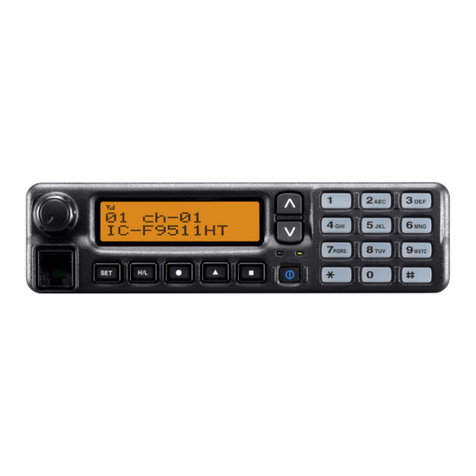
Icom
Icom IC-iF9511HT User manual
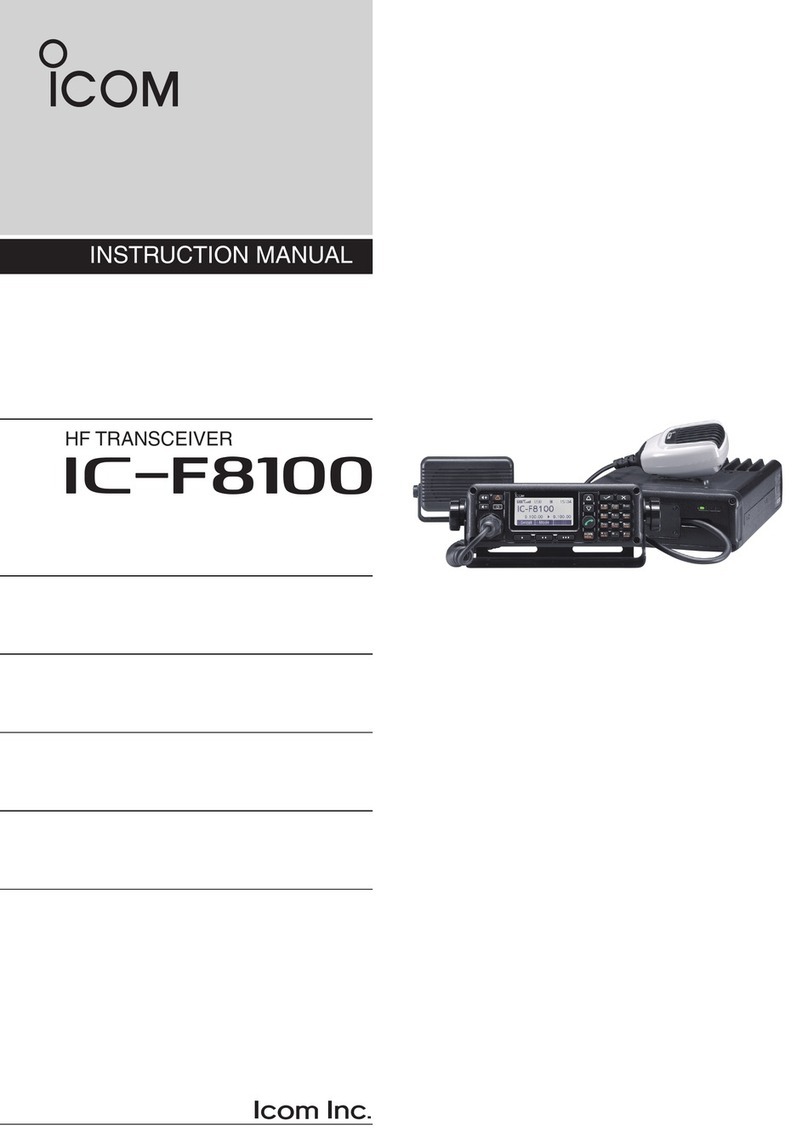
Icom
Icom IC-F8100 User manual

Icom
Icom IC-E90 User manual
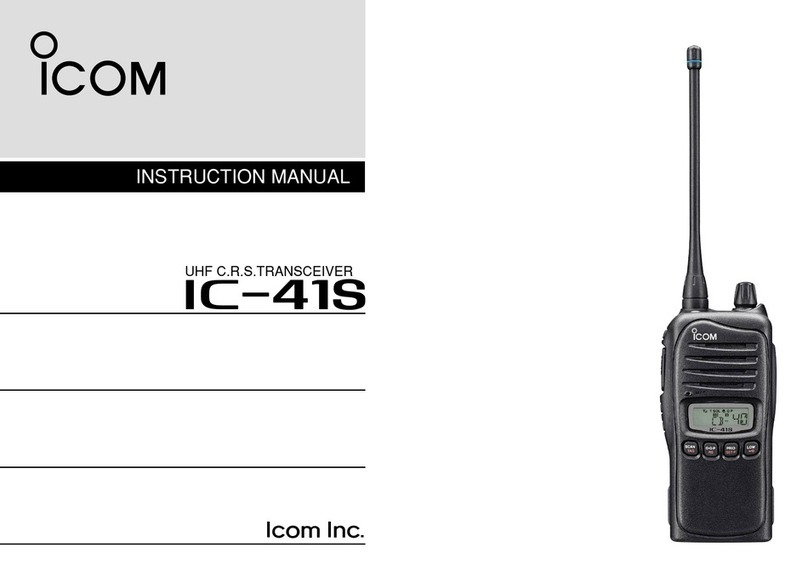
Icom
Icom IC-41S User manual
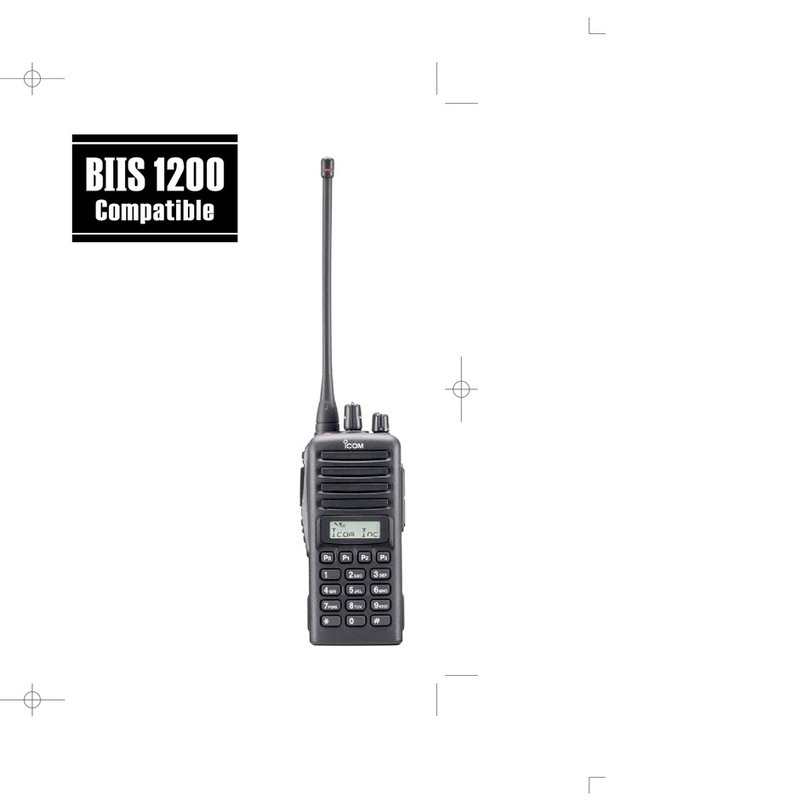
Icom
Icom iF44GT/GS User manual
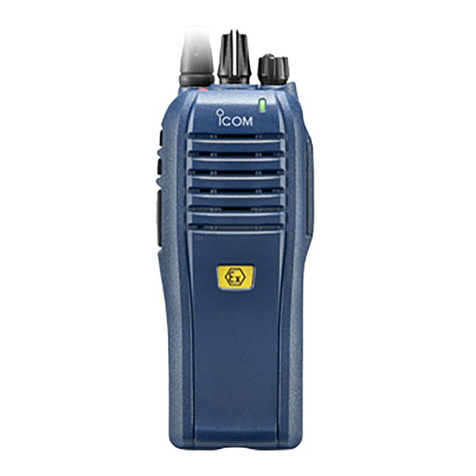
Icom
Icom IDAS F3201DEX 14 User manual
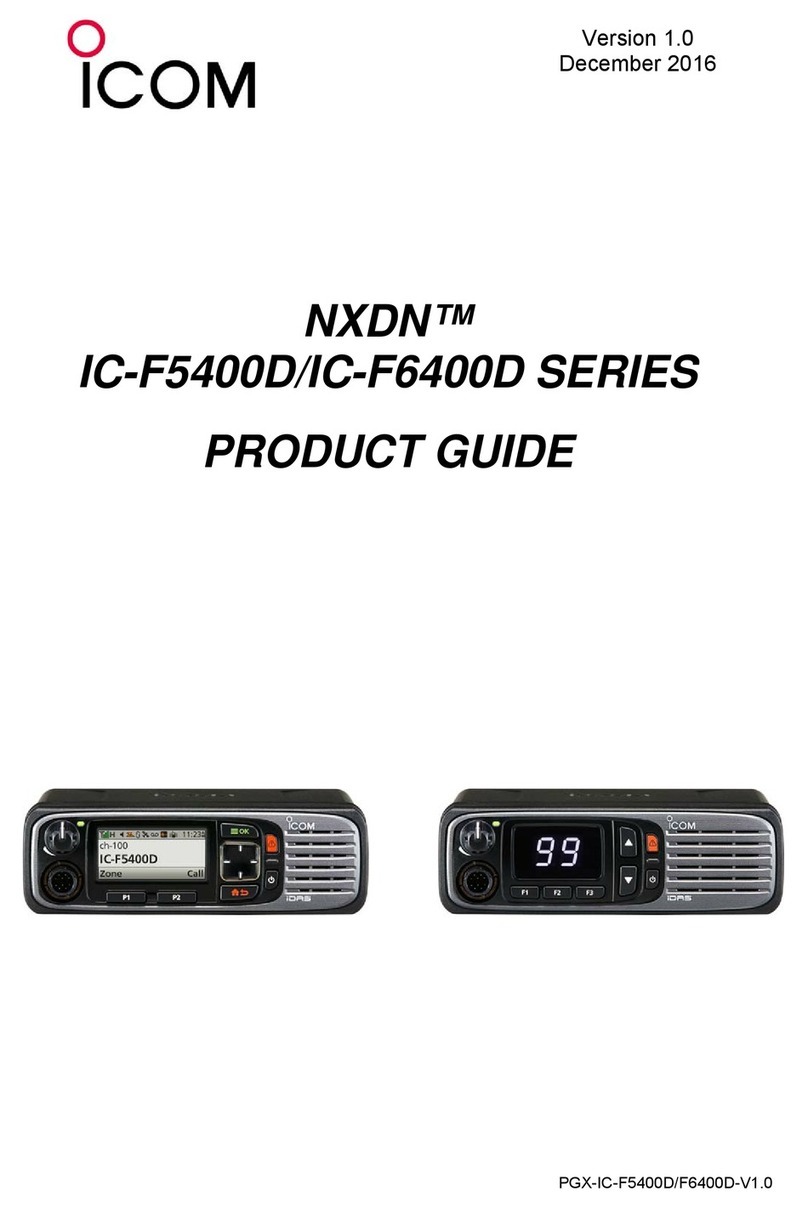
Icom
Icom NXDN IC-F5400D SERIES User manual

Icom
Icom IC-M422 User manual

Icom
Icom IC-M85E User manual
